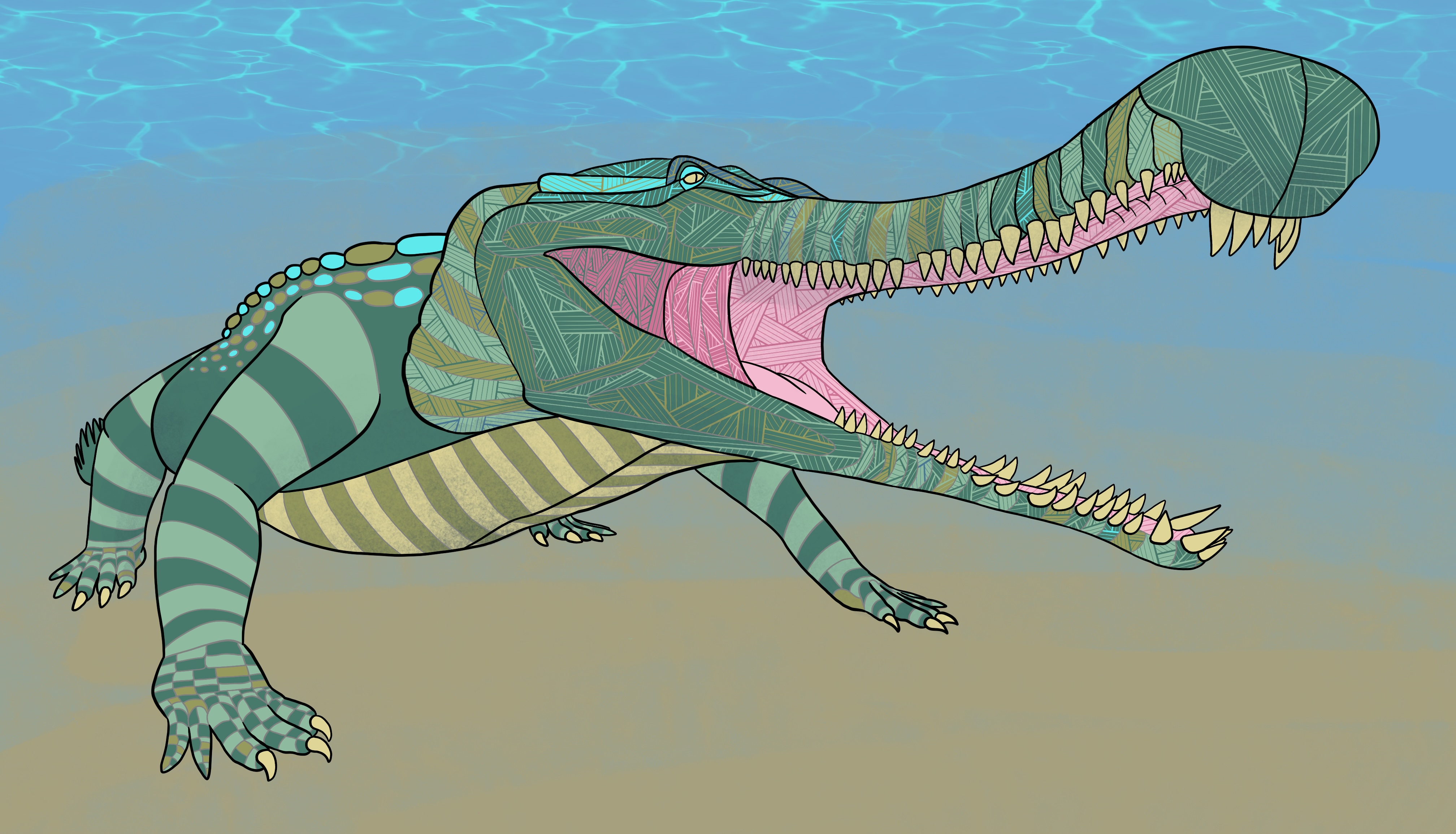The other thing besides birding that I always make sure to do when I travel is to hit up the local natural history museum. In Paris, that’s the Galerie de Paléontologie et d’Anatomie Comparée located on the eastern end of the botanical garden, NOT the Muséum National d’Histoire Naturelle, which is on the other end of the gardens and contains taxidermied animals. The paleontology gallery is quite a small building, but is packed absolutely to the gills with fossils as well as the skeletons of modern animals.
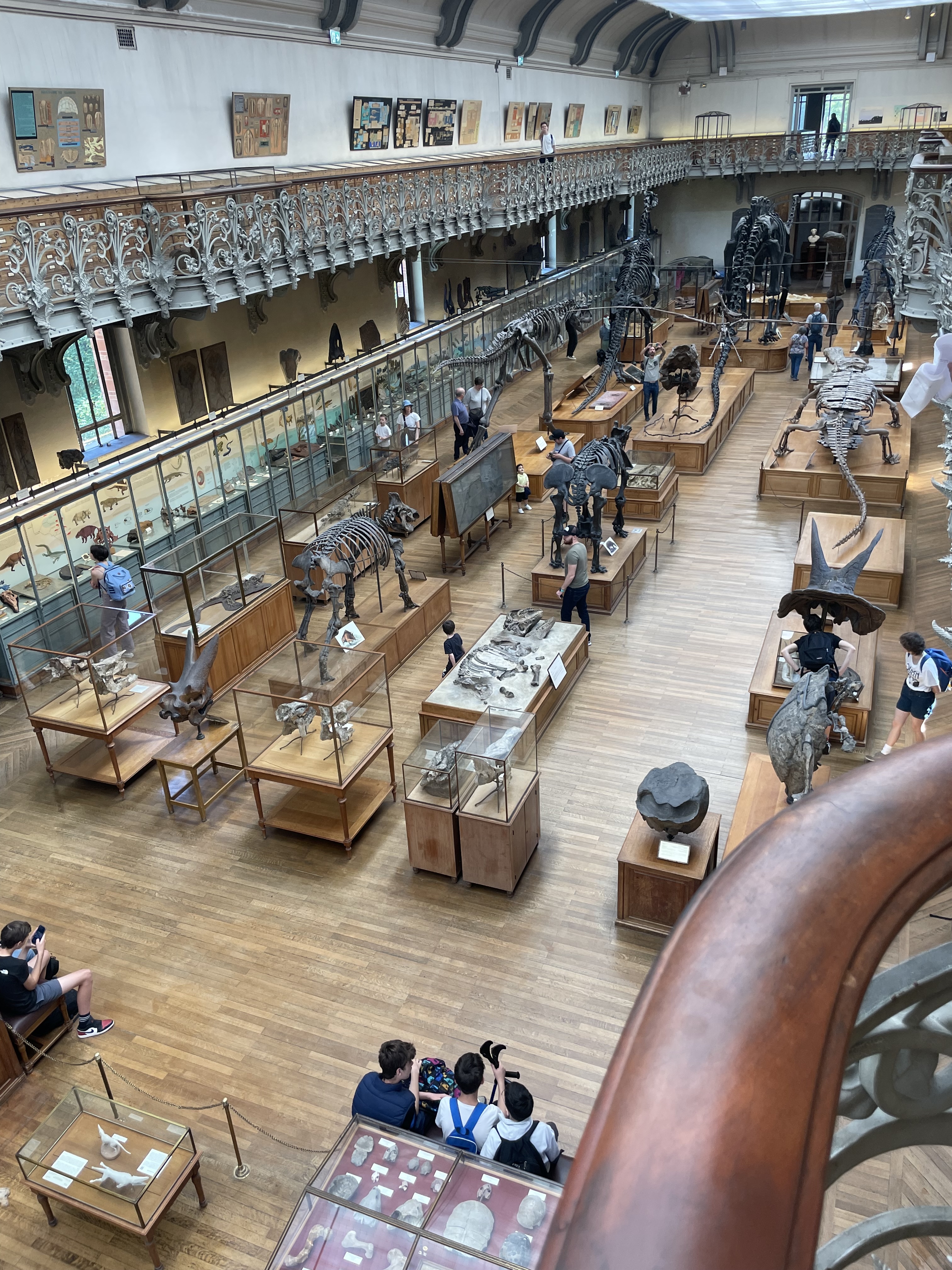
This is a very Gilded Age way to display fossils, with lots of mounted skeletons facing the same direction and no prescribed path for visitors to walk. Cool to see a museum that’s not only a tribute to the deep past, but also to the more recent past!
The main downside to this museum was that there were no English translations anywhere. I took photos of as many signs as I could and translated them later, but there are definitely a lot of things I missed due to not knowing French.
The first thing you see when you enter the museum is a really strange statue of an orangutan choking out a human:
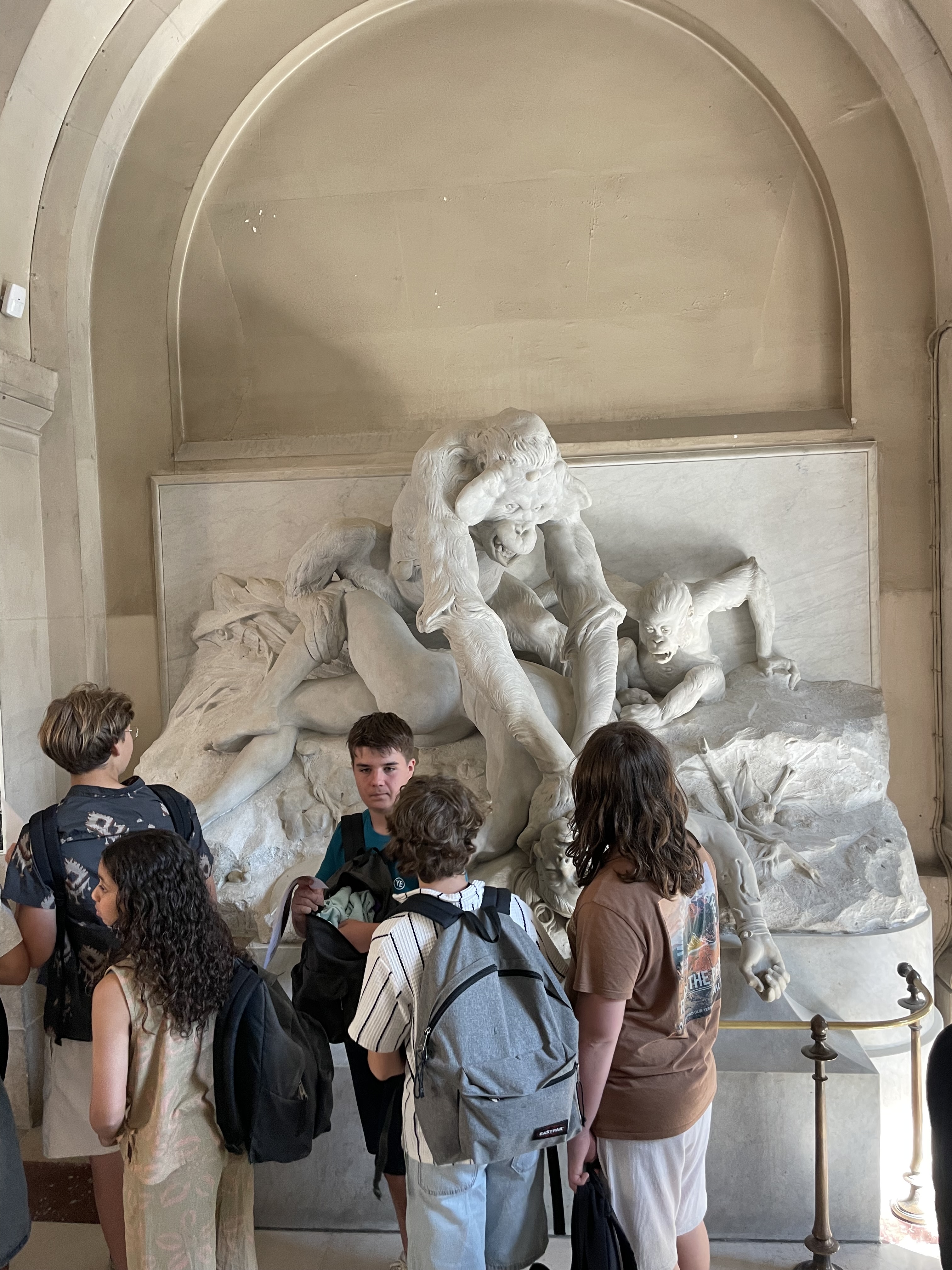
(I couldn’t get a clear photo of it because it was behind the line of people waiting to get in.)
Apparently this orangutan is called Maurice (which is maybe why the orangutan character in Rise of the Planet of the Apes was named that?), and was said to have killed one of his Southeast Asian handlers. However, from Googling around, it seems that this story may be apocryphal. The sculptor is Emmanuel Fremiet, who is known for his sculptures incorporating animals, including one of a gorilla kidnapping a woman and one of a man fighting a bear. I’m not sure why the museum has this; maybe just because the sculptor was famous and French?
Entering the ground floor hall, there is an overwhelming number of mounted skeletons of modern animals.
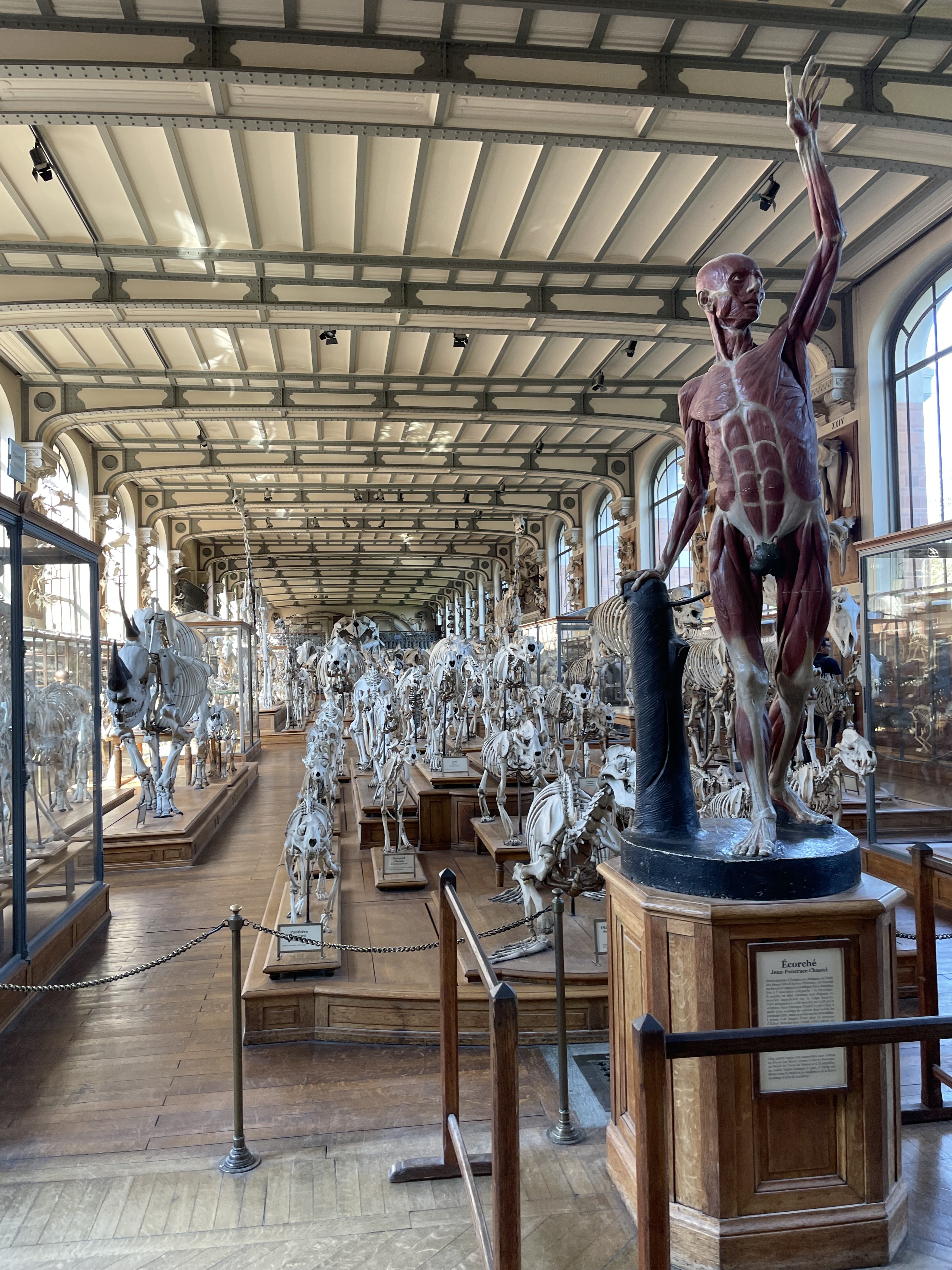
But let’s get on upstairs before the field trip kids realize there are no dinosaurs in here, shall we?
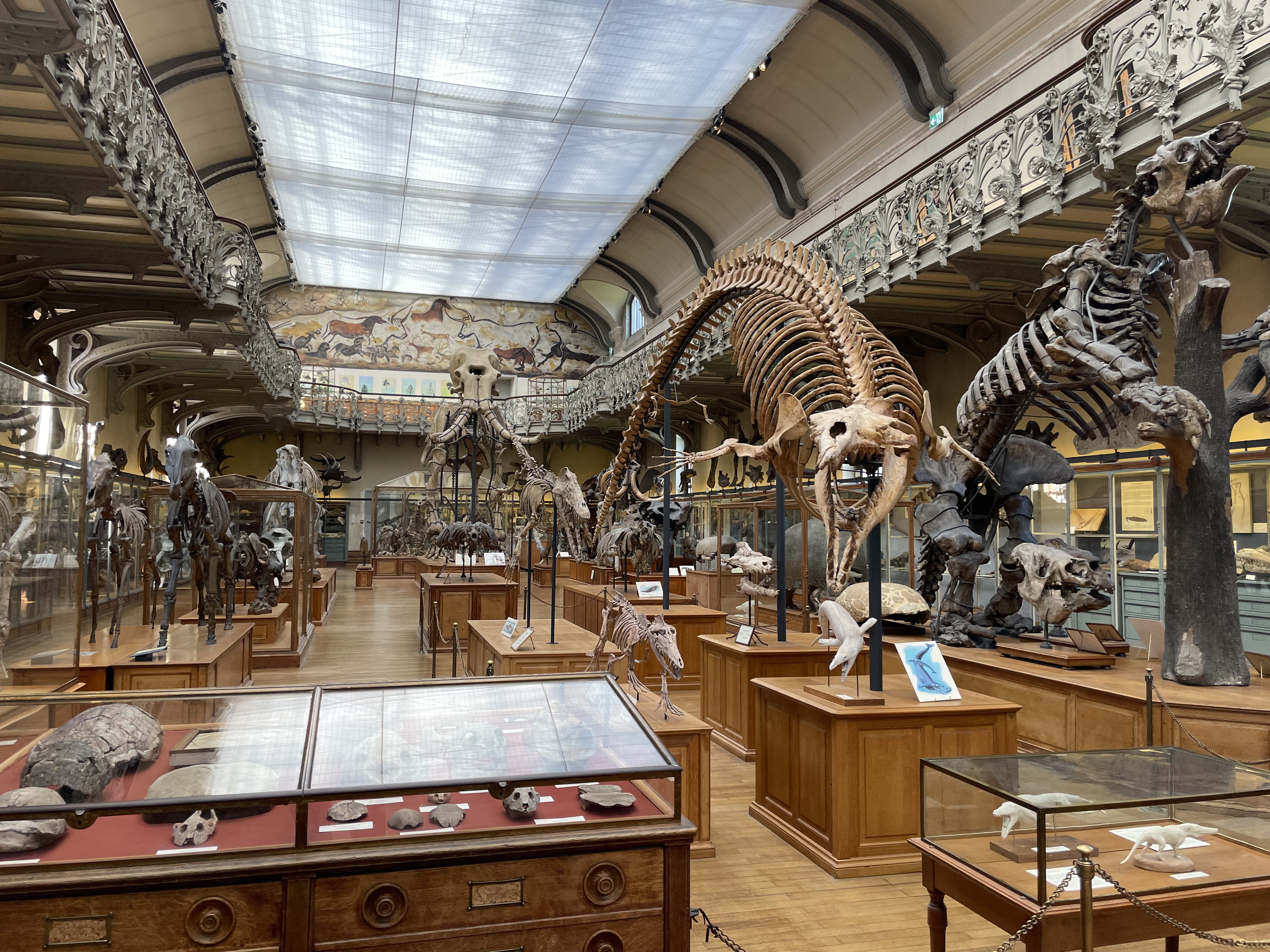
As in most museums, the large mounted fossils are a combination of original, composite (fossil plus fabricated parts to fill in the blanks), and cast material (copies of real fossils). A lot of the biggest dinosaur skeletons in here, like Carnotaurus and their mounted sauropod, are full casts, which I didn’t take pictures of. But they did still have plenty of interesting original fossils. I’m not going to go age by age because (a) I only translated a sporadic selection of things, and (b) there was no clear walking path to go in a particular direction in time. I’m just going to do a highlight reel.
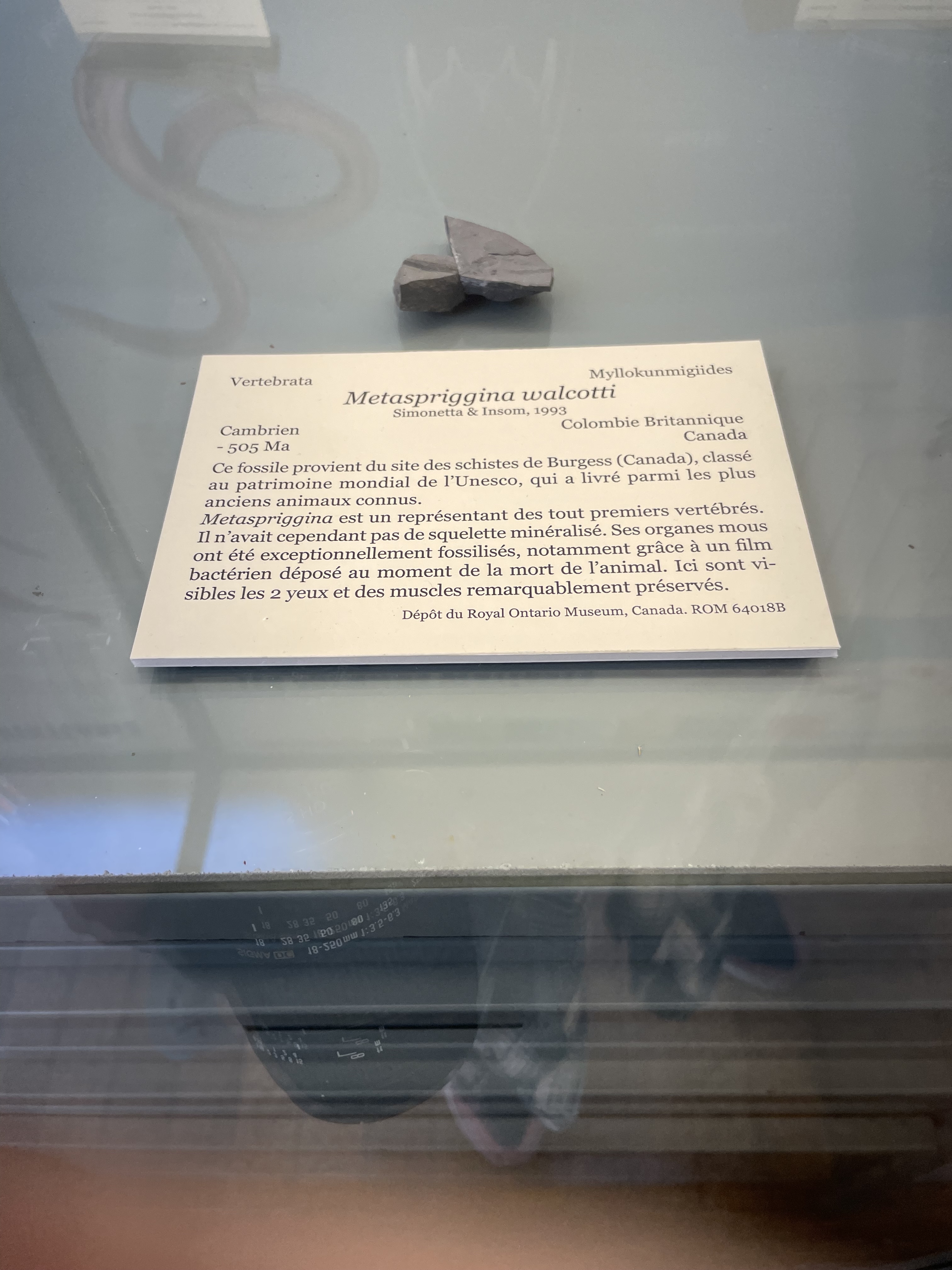
Let’s start with some of the oldest fossils. They have an original Metaspriggina here, which is a really, really ancient (pre-Cambrian) early chordate, or ancestor of animals with backbones. Unfortunately, it’s not really clear what we’re looking at in this fossil.
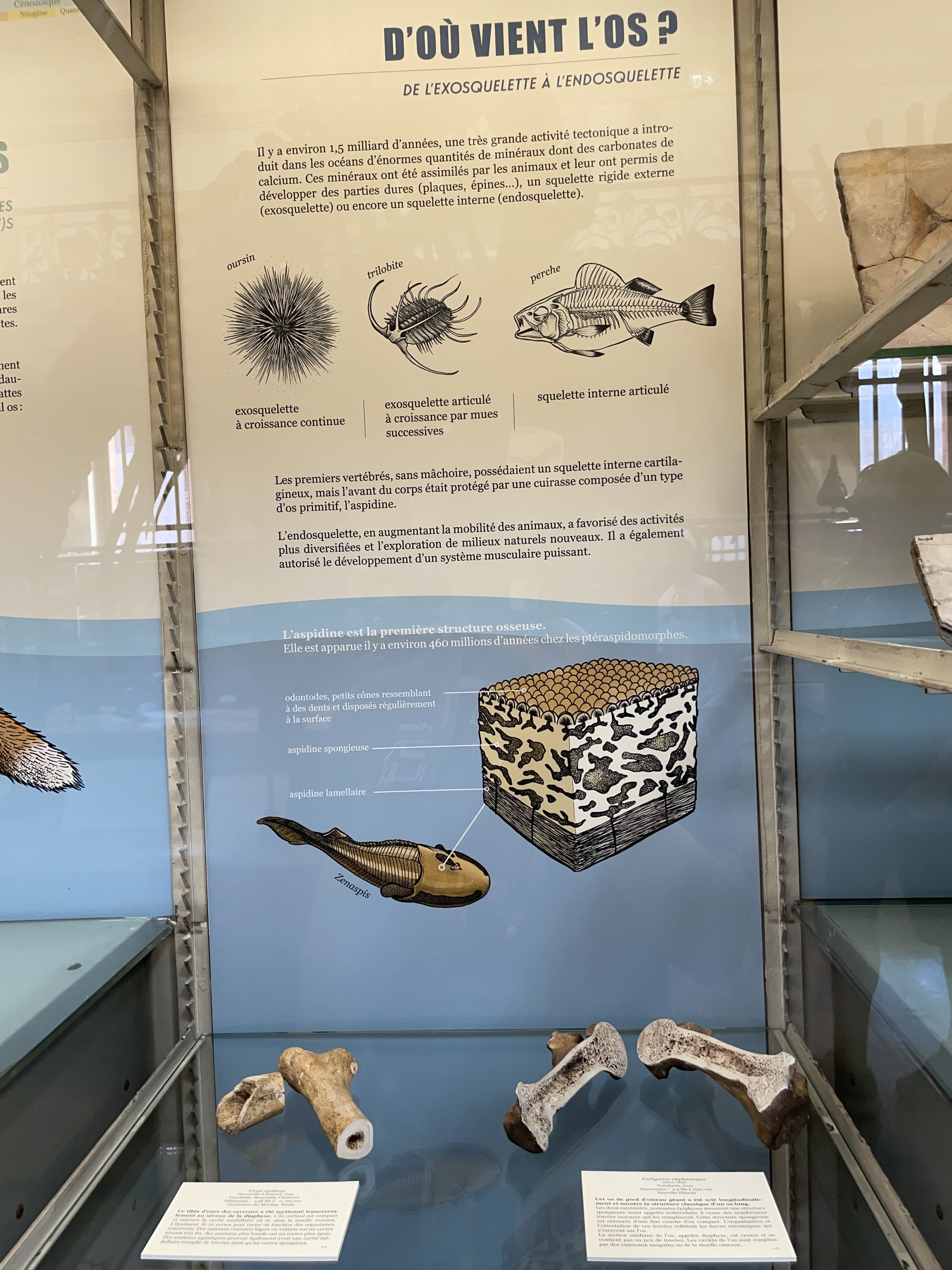
The info in this display was new to me - it explains how pterapsidomorphs, or an early type of jawless fish from the Ordovician, employed a primitive type of bone called aspidine, which was different in structure from modern bone. At the bottom, there is a transverse cross-section of a cave bear’s leg bone (left), showing the thick walls and hollow center, and a longitudinal cross-section of a moa (giant bird) foot bone, showing the thin walls and numerous trabeculae (struts), as well as the way that the bone ends differ from the center.
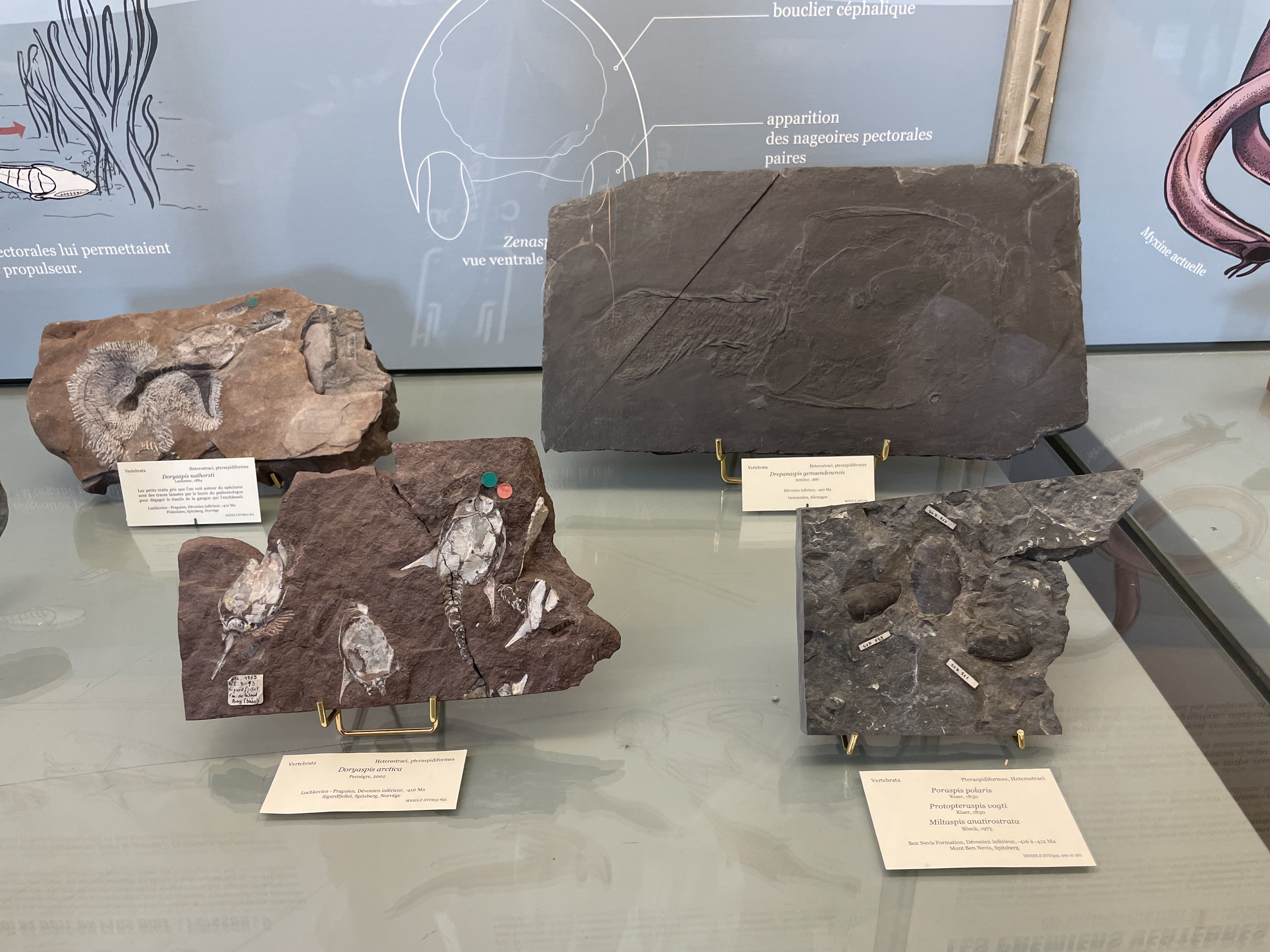
Jumping ahead to the Devonian, here are some neat jawless fishes. The caption on the rear left one says that the gray lines aren’t part of the fossil but are chisel marks, which is a good thing to call out, because they look a lot like how sting rays’ fins get fossilized. I wonder why this fossil was prepared this way? I’ve never seen this kind of thing before.
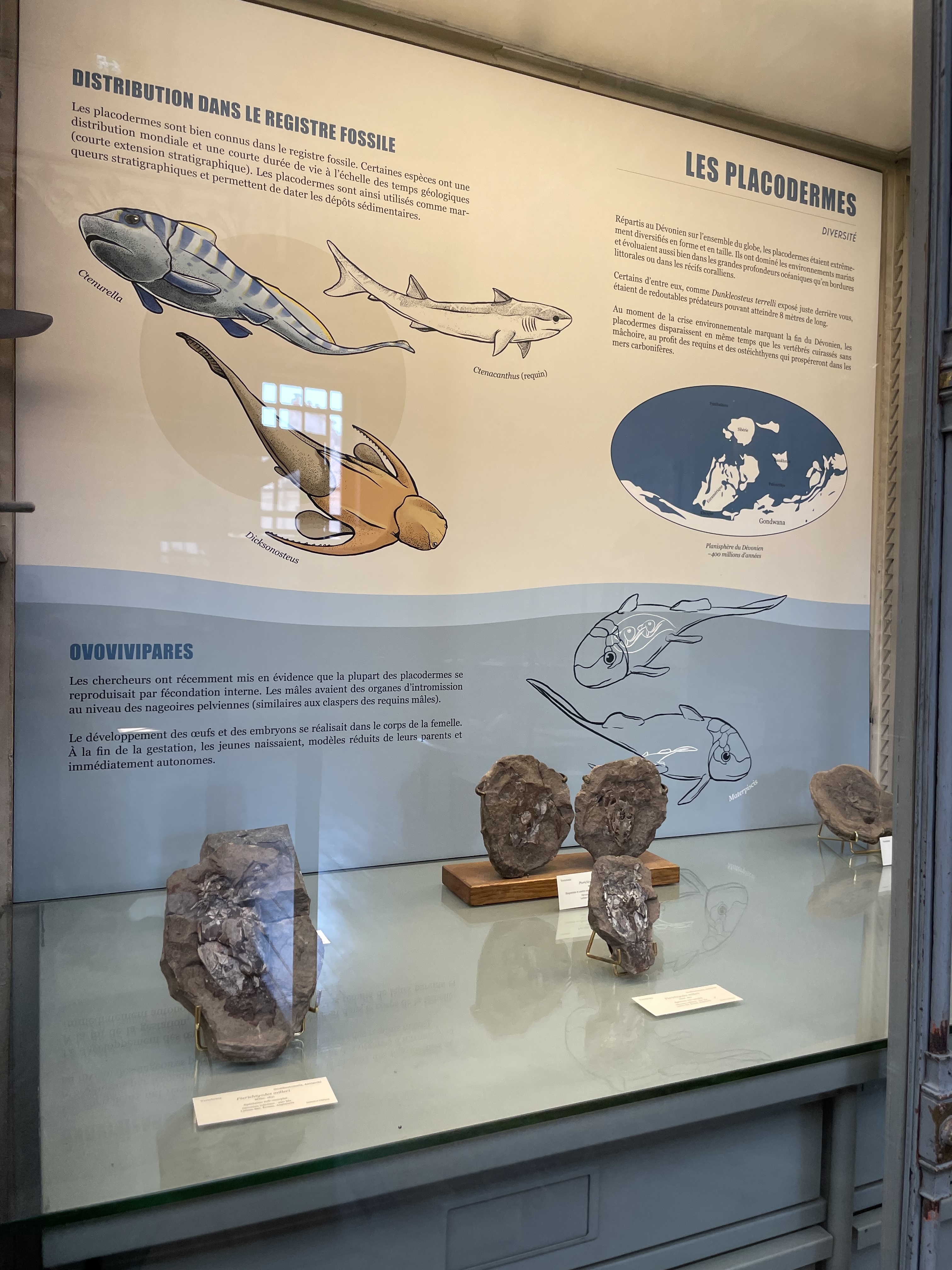
Moving ahead to the end of the Devonian, here are some small placoderms (the family of fish with bony armor that includes the famous Dunkleosteus) and some info on them. Their drawing of Ctenurella is pretty decent: its bony head plates are not visible on the outside of its body, a common error. I’m not sure why the artist decided to put a fin halfway along its tail, but I’m pretty sure we don’t know enough about this genus to know for sure whether that’s wrong.
The sign states that placoderms were ovoviviparous, or giving live birth by holding the eggs inside the female’s body, and that the males had claspers they used for internal fertilization, similar to sharks. This is accurate to the extent that we know - there have been pregnant placoderm fossils found with young preserved inside, as well as a specimen named Materpiscis (“mother fish”) that died in the process of giving birth, with even the umbilical cord intact. This sign also says that the young would have been basically mini adults and self-sufficient right away. As far as I could find, we don’t know whether placoderms practiced parental care, but we do have some juvenile Bothriolepis specimens that do look like mini adults, so this is plausible.
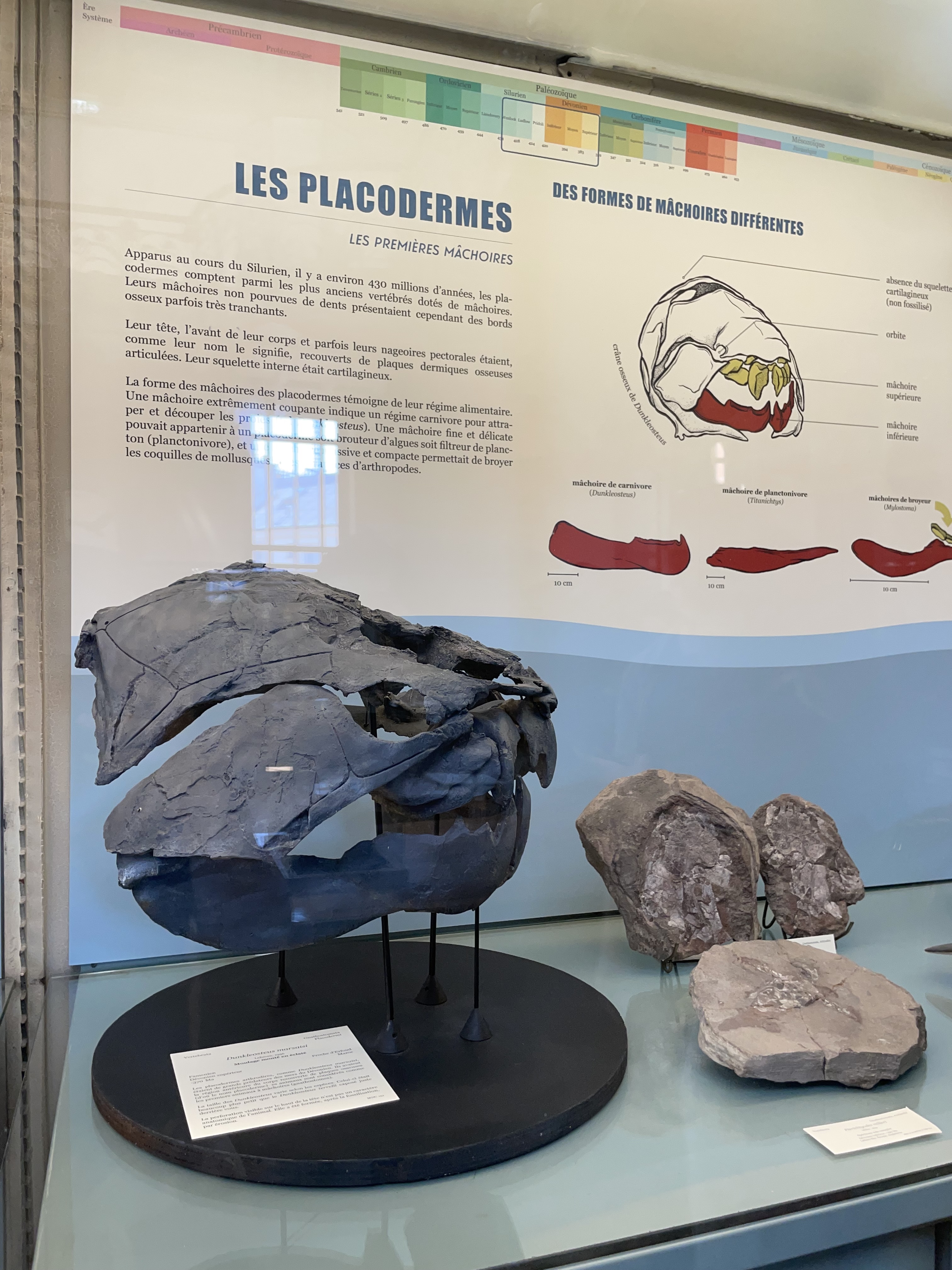
Here’s one of the three Dunkleosteus the museum had on display. The sign behind it says that even though placoderms didn’t have teeth, you can tell by the shape of the jaw what they were feeding on, and gives examples of a predator’s jaw plates, a filter feeder’s, and a durophage’s. I think this is a cool detail, and it’s not something I’ve seen before! I knew placoderms filled all kinds of niches, but seeing the different jaw types involved was new to me.
The sign directly under the Dunk fossil explains that the hole in the top of the head is not part of the fossil but was caused by some aspect of its preservation. I appreciate them pointing this out.
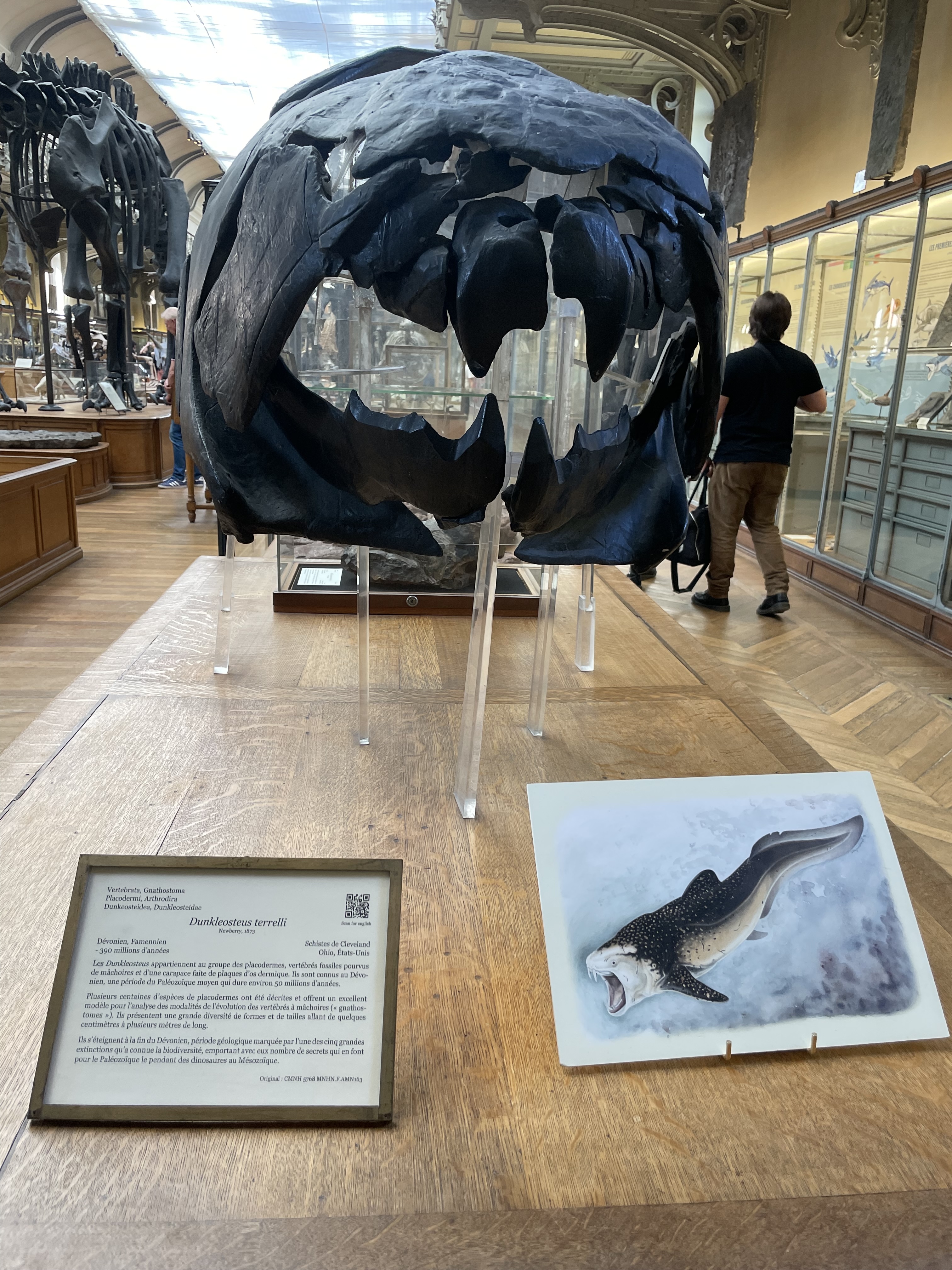
Here’s Dunk Number 2, the biggest of the three. Alongside it is an outdated life reconstruction, with the old-fashioned eel-like fin and long body.
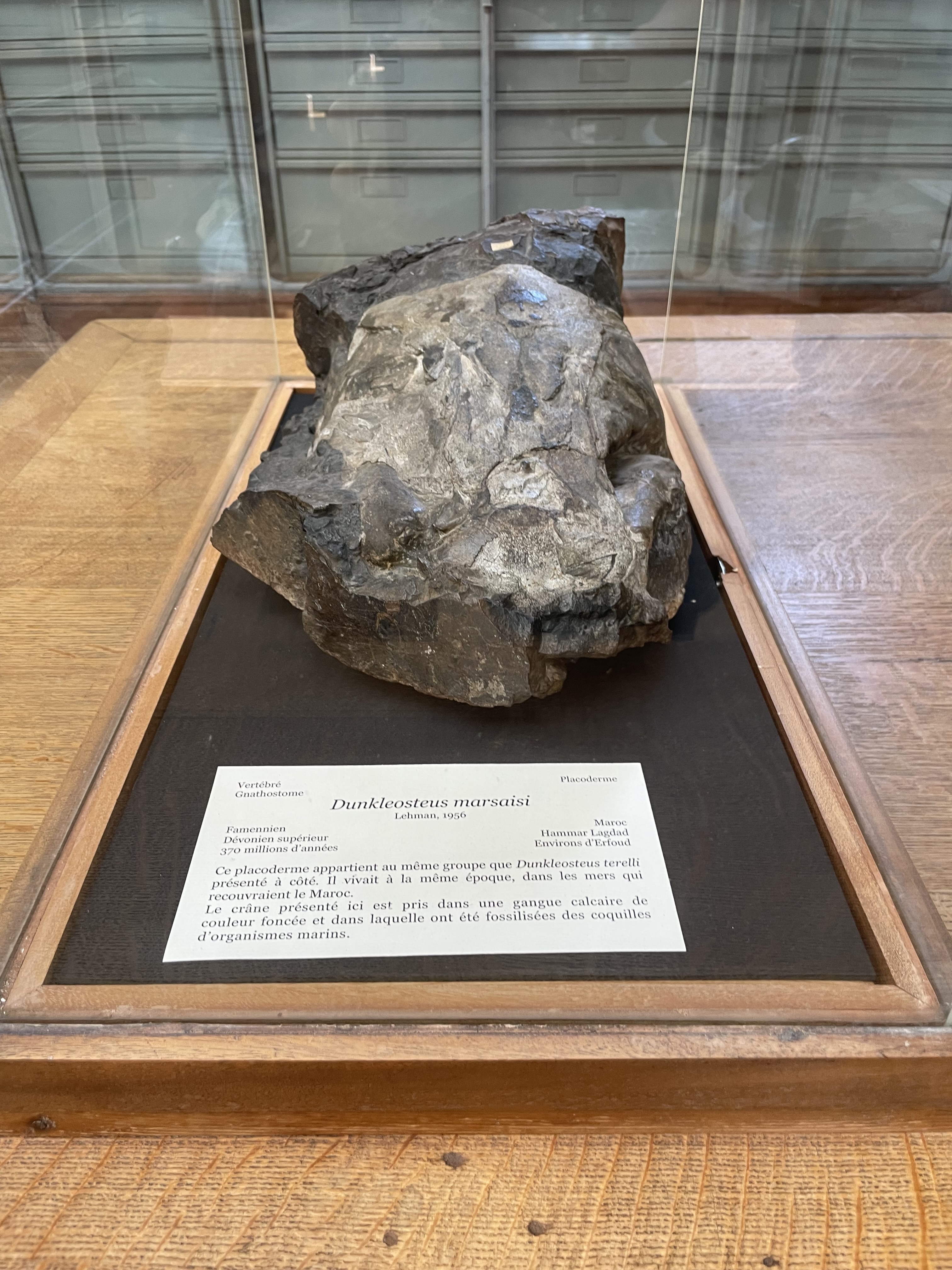
And here’s the final Dunkleosteus, the smallest of the three, and embedded in a rock. I’ve never seen one preserved this way. It looks a lot more similar to other slabbed placoderms I’ve seen in museums. Seems like only the big ones merit taking out piece by piece and mounting!
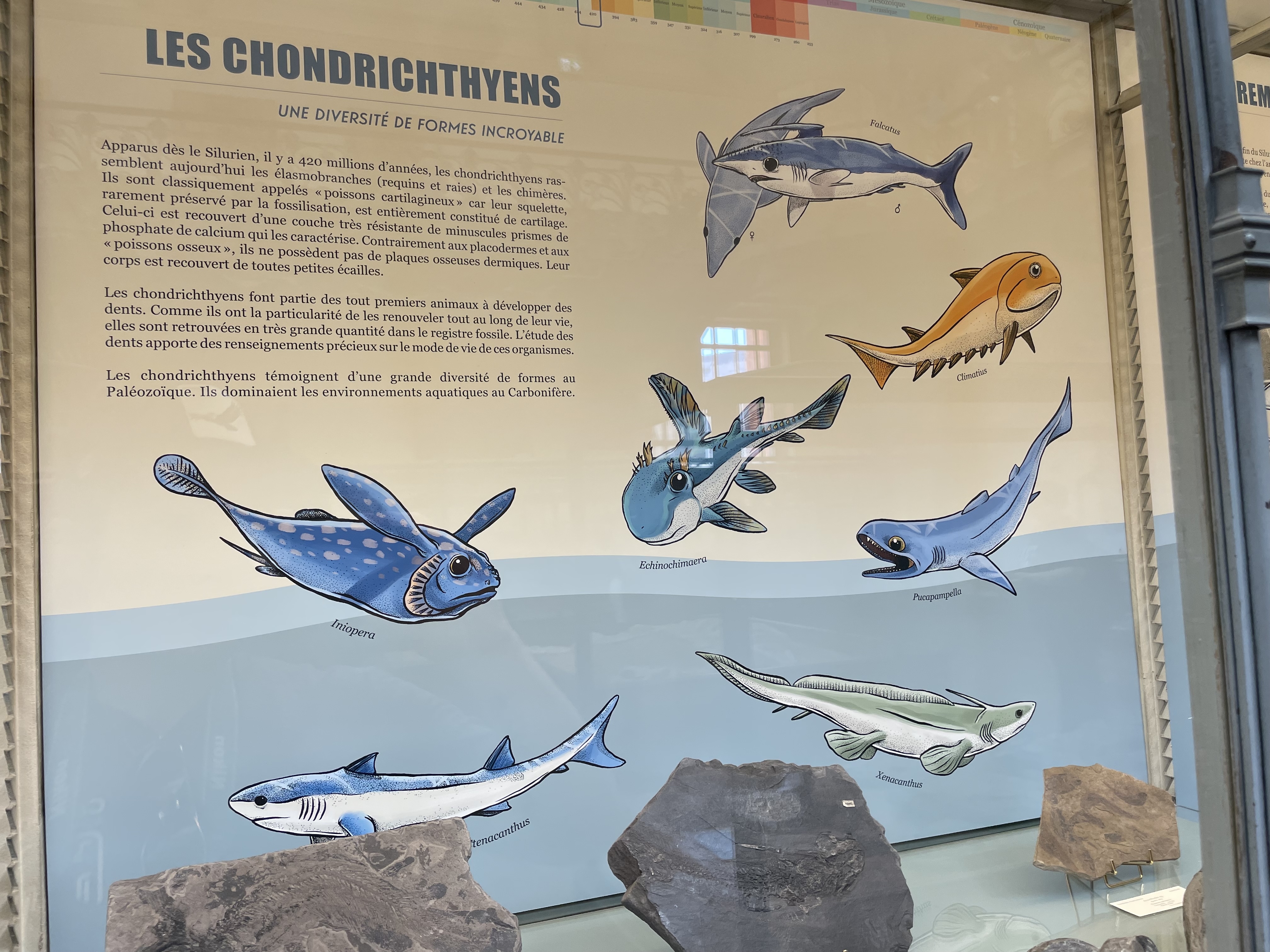
Contemporary to the placoderms are the early cartilaginous fish, including modern sharks and rays. I like how they highlight the many crazy experimental anatomies early sharks exhibited in their art. I’d never heard of Iniopera before, but it’s so funny-looking! I also just like the word “incroyable”.
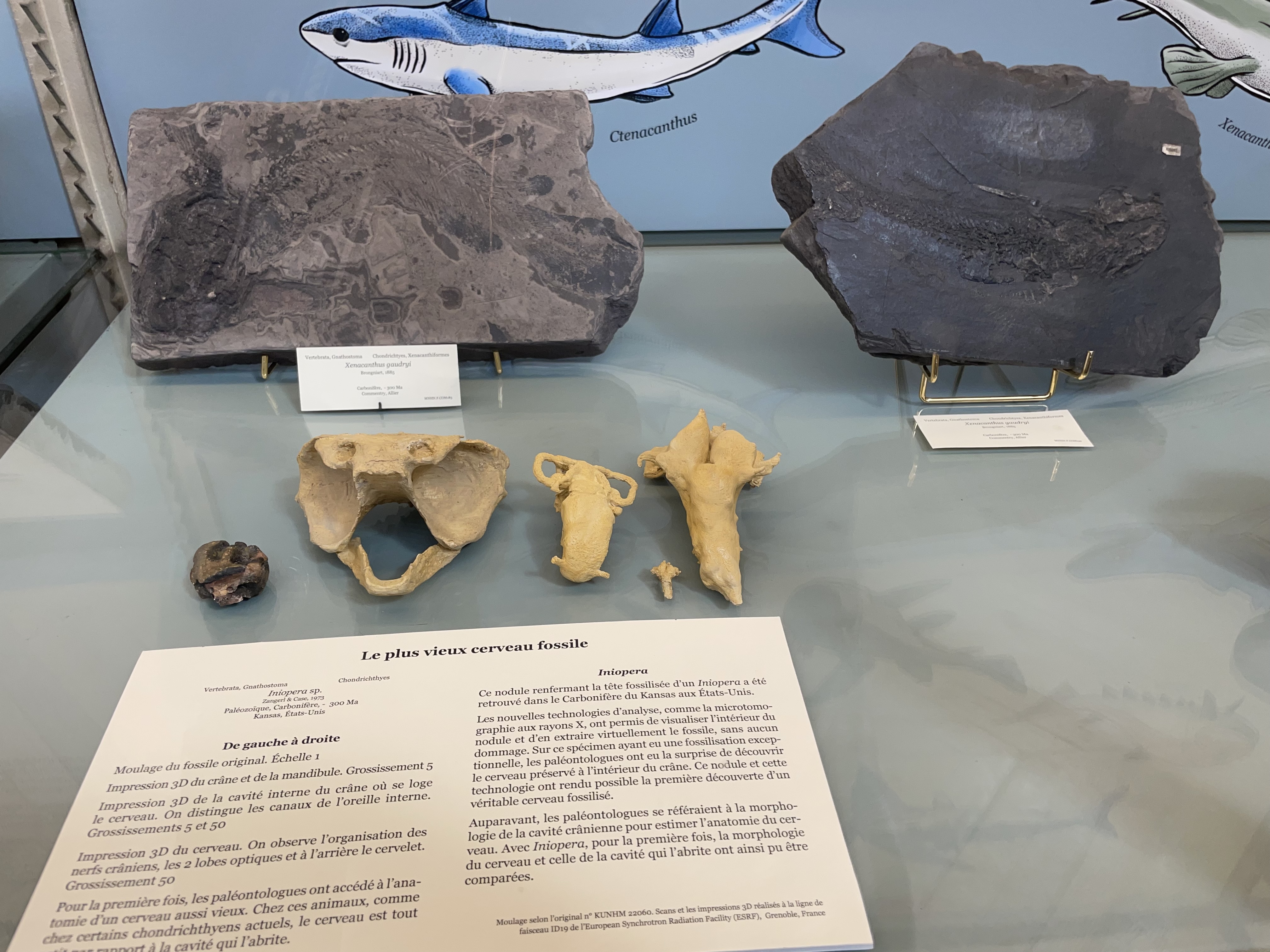
This was an interesting one: the black blob on the left is a nodule containing the head of Iniopera, which they scanned and resized to construct the cast, second from left, at 5x scale. The preservation actually included both the skull bones and the actual brain, so they also made casts of these: the endocast of the skull cavity is the shape in the middle with the two “handles” at 50x scale, and then the brain is shown at both 5x (matching the skull) and 50x scale on the right side. This highlights the limitations of drawing conclusions about an animal’s brain based on the size and shape of its braincase, and/or the effects of taphonomy (the fossilization/preservation process) on brain tissue. (This last is the reason behind the persistent myth that koala brains only take up 60% of their braincase. The specimens they were studying had been pickled in a way that made them shrink. In fact, koalas have completely normal-sized brains for their head size.)

This is a cool mini-slab! The largest fish there is the one on the sign, Scyliorhinus, which is a genus of catsharks that’s still around today. The sign says “here we can also see 3 smaller actinopterygians” - two that are obvious plus one in the mouth of the shark.
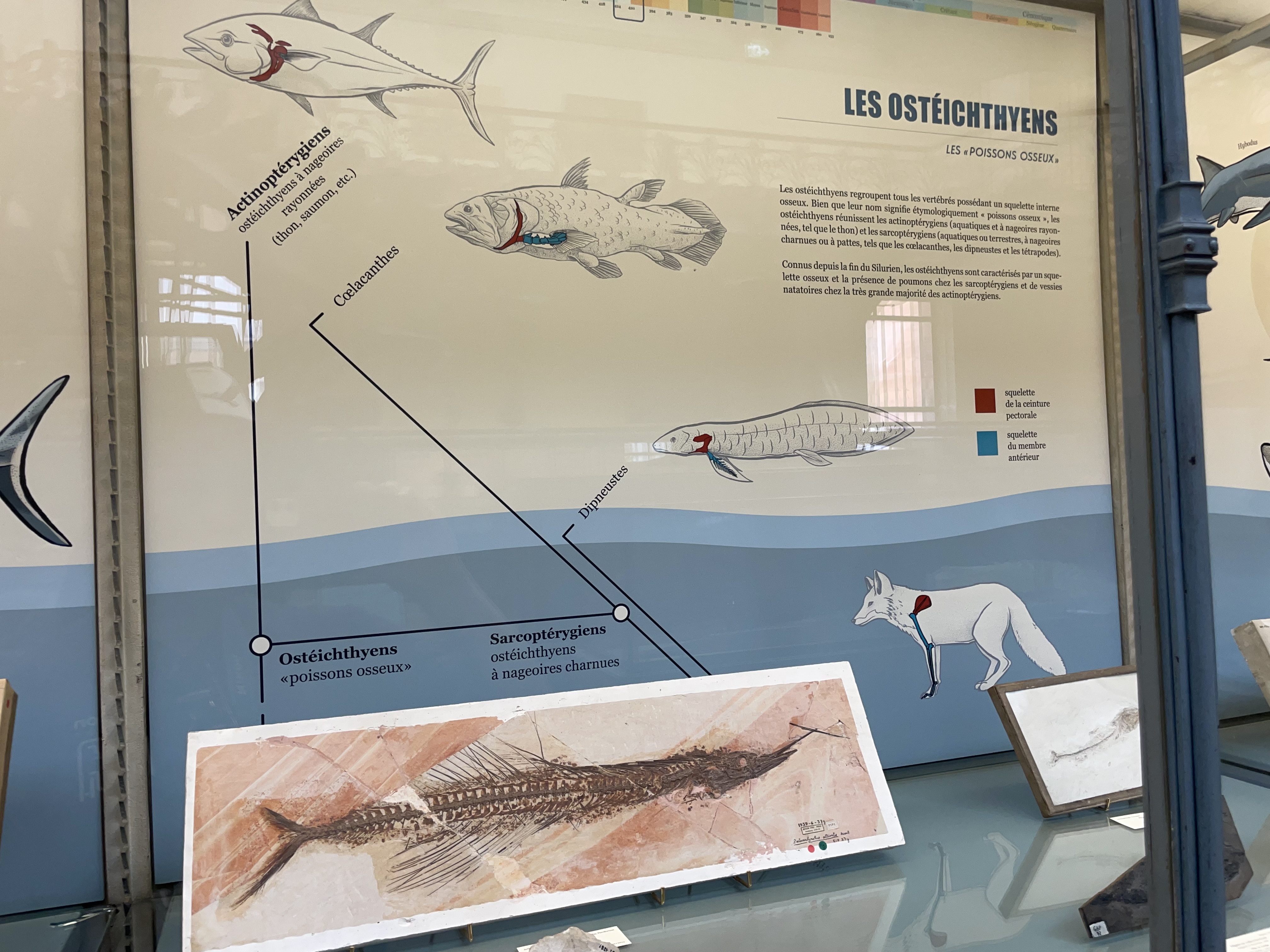
And here’s the final important fish group, the bony fish. I like how they show the homologous structures between the different lineages.

Here are a bunch of temnospondyls, a type of early amphibian, that died together when their swamp dried up. This happens often in places that get sporadic rain or flash floods, but in the past it would’ve been a lot more dramatic, since these animals are each the size of a small gator!
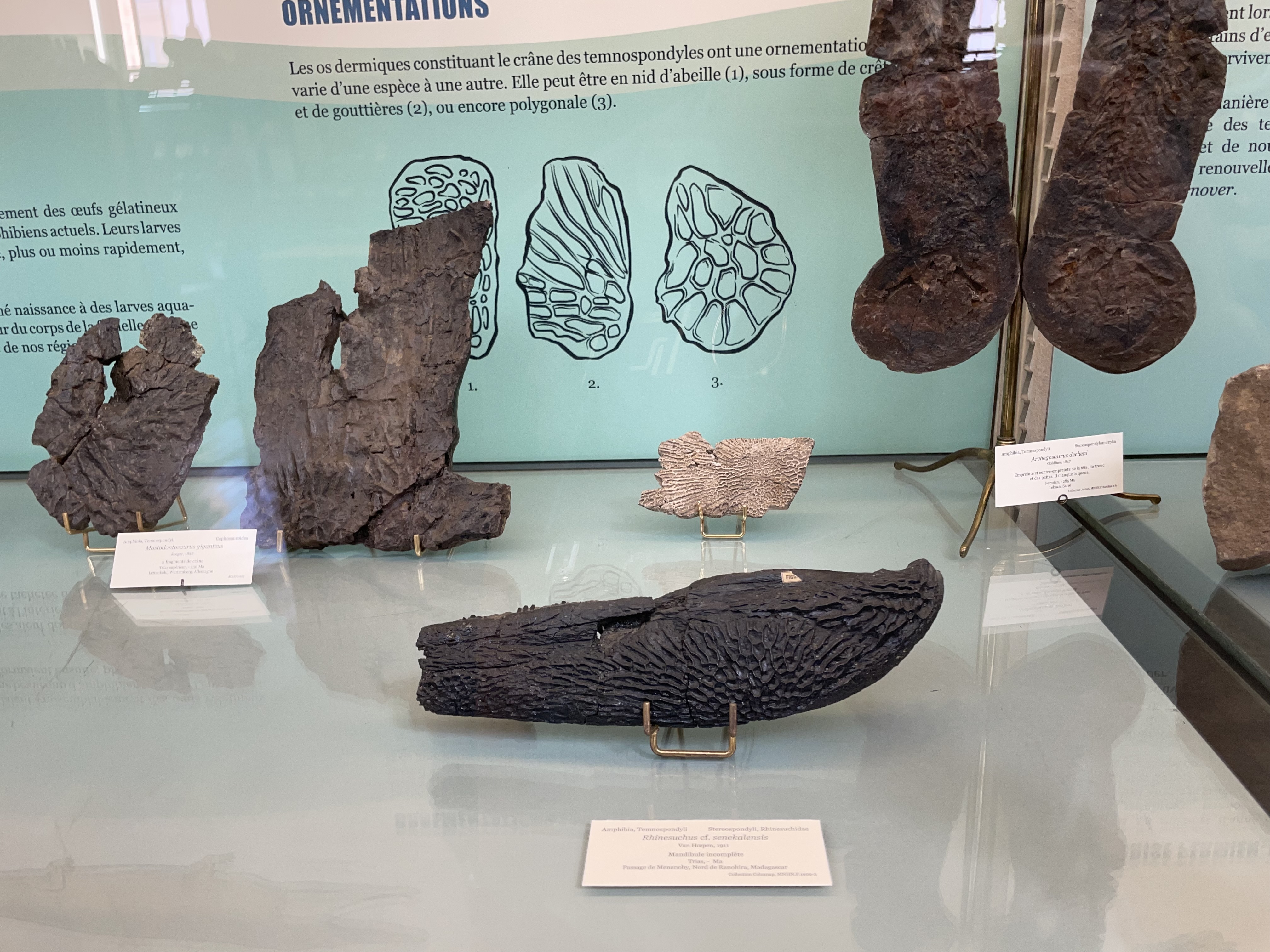
Here are some fragments of other temnospondyl skulls that show different patterns in the rugosity of the bone. Like crocs, temnospondyl skin was stuck directly to the bone with minimal flesh in between, so you can tell a lot about the outer appearance of the animal from the patterns in the bone surface, called osteological correlates. However, this sign doesn’t tell you what each means. What do they mean?
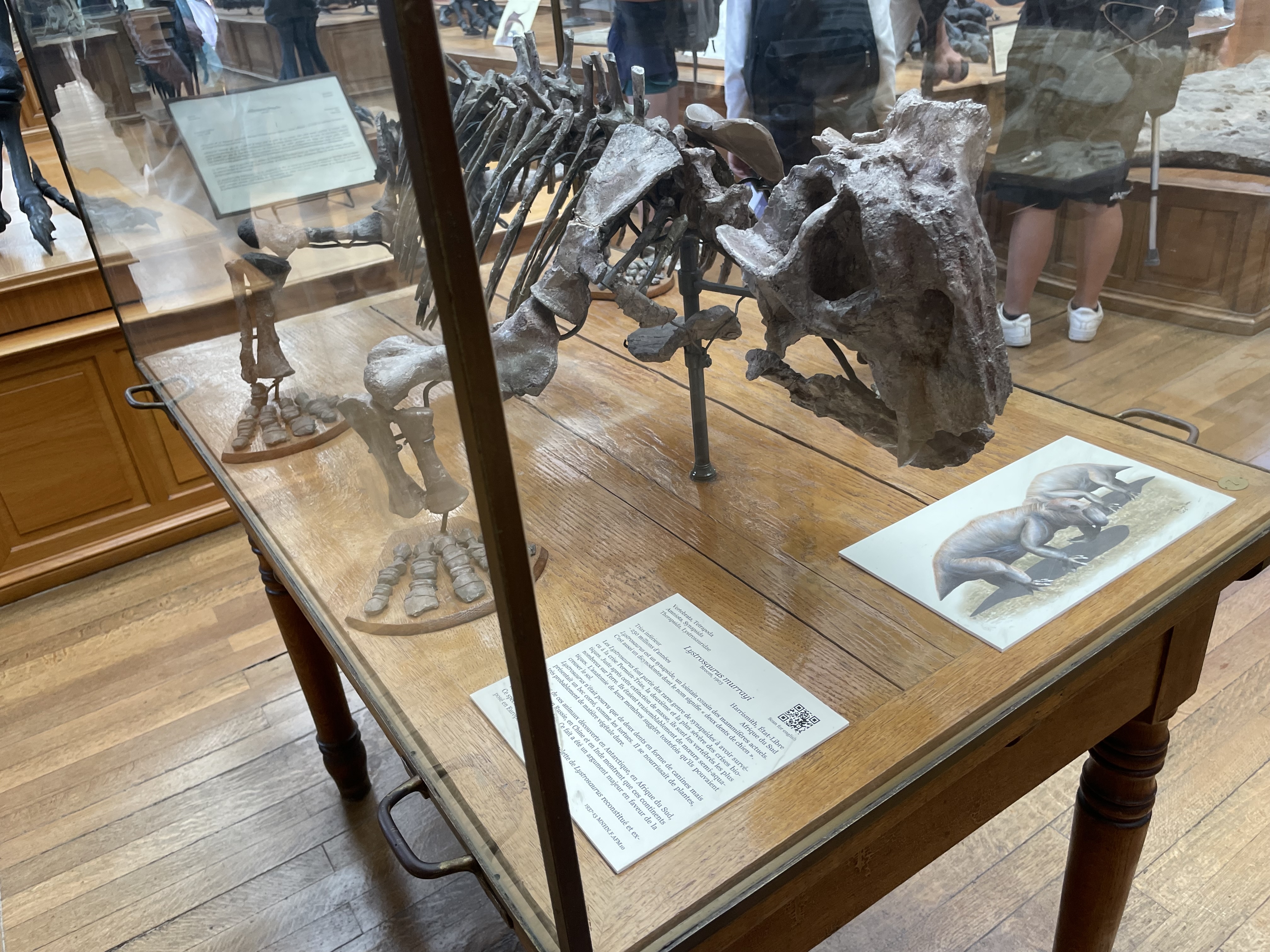
Here is a little guy I am particularly fond of, Lystrosaurus! I’ve written about him twice before on the blog, once in a profile of his own and once in the context of other Permian synapsids. But I think this actually might be my first time seeing a mounted skeleton of one! Everyone always calls them “bulldog-sized”, but this was definitely more like sheep-sized. But apparently there were four species of Lystrosaurus, and three of them were truly knee-high, but murrayi was quite a bit larger. TIL! The one weird thing about this display is it suggests that Lystrosaurus was semi-aquatic. This is a bit of a fringe theory; there’s no direct evidence for it, but it has been proposed by some researchers as being a potential reason this animal was such a good survivor. But the French sign also says it was adapted for digging, which seems to conflict with also being semi-aquatic? Confusing.
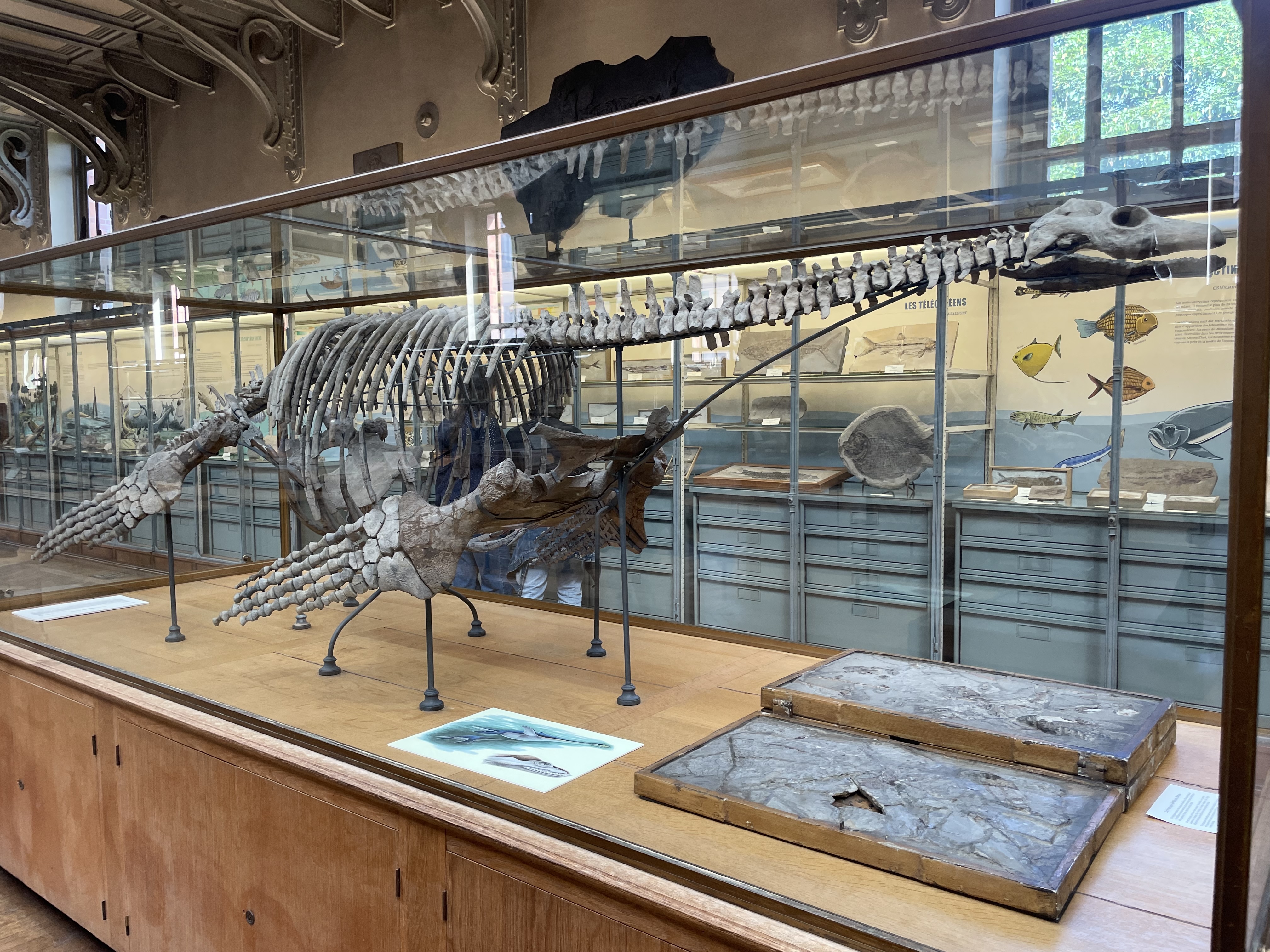
Onward to the Mesozoic! Here is a case shared by the plesiosaur Cryptoclidus and the “Monte Bolca Triptych”, which is a totally unrelated thing from the Eocene, millions of years later. Not sure why they displayed these two fossils together? Apparently the Count of Monte Bolca gave this fossil in person to Napoleon. Imagine him receiving it… “Uh… thanks? Put in in the wagon, I guess”
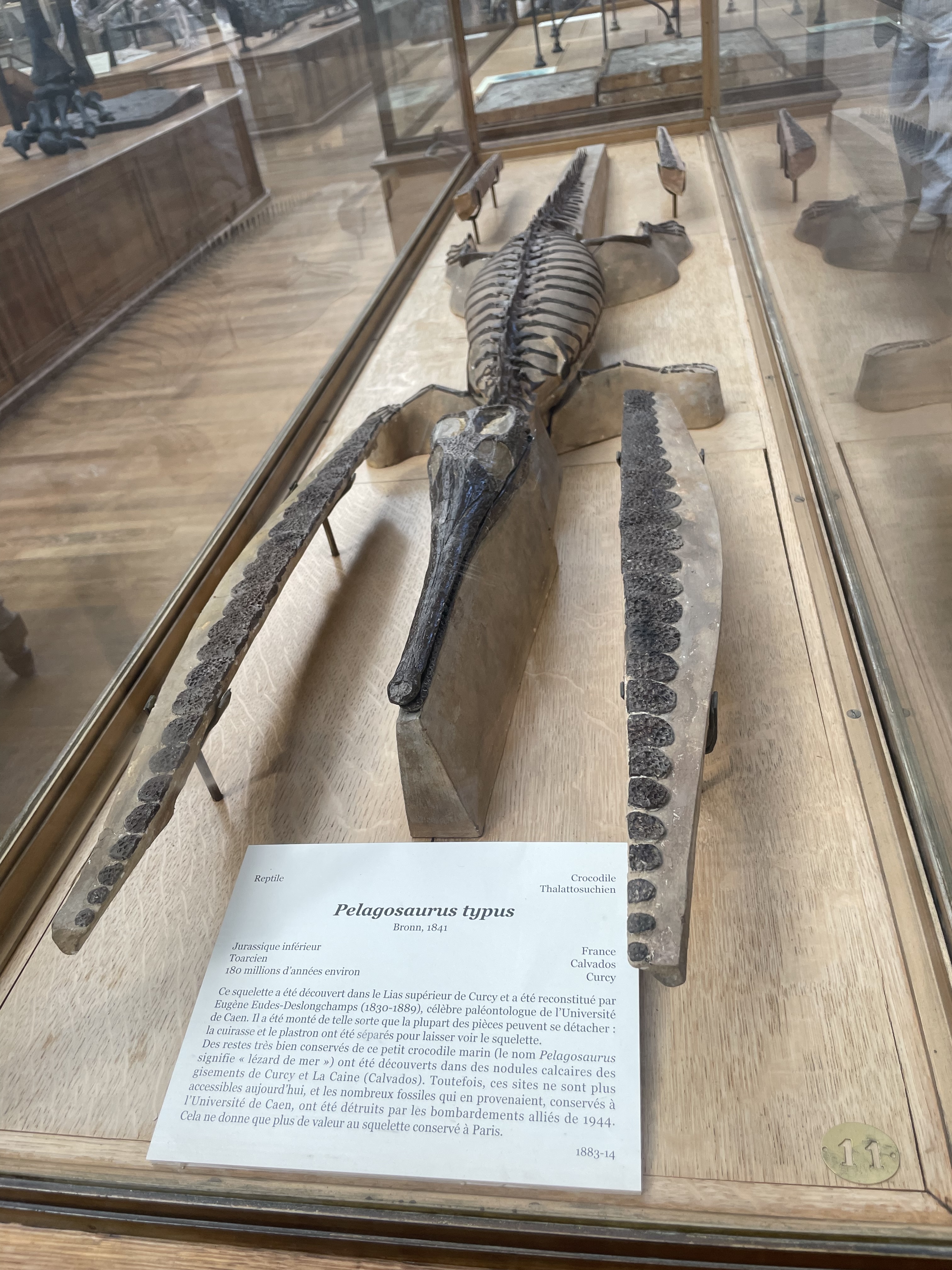
This thalattosuchian (marine croc), Pelagosaurus, is mounted with its osteoderms separated from its body, enabling viewers to see the body more clearly. According to the sign, the quarry this came from was destroyed by bombs during World War 2. But the sign doesn’t say anything about how this animal lived, in particular.
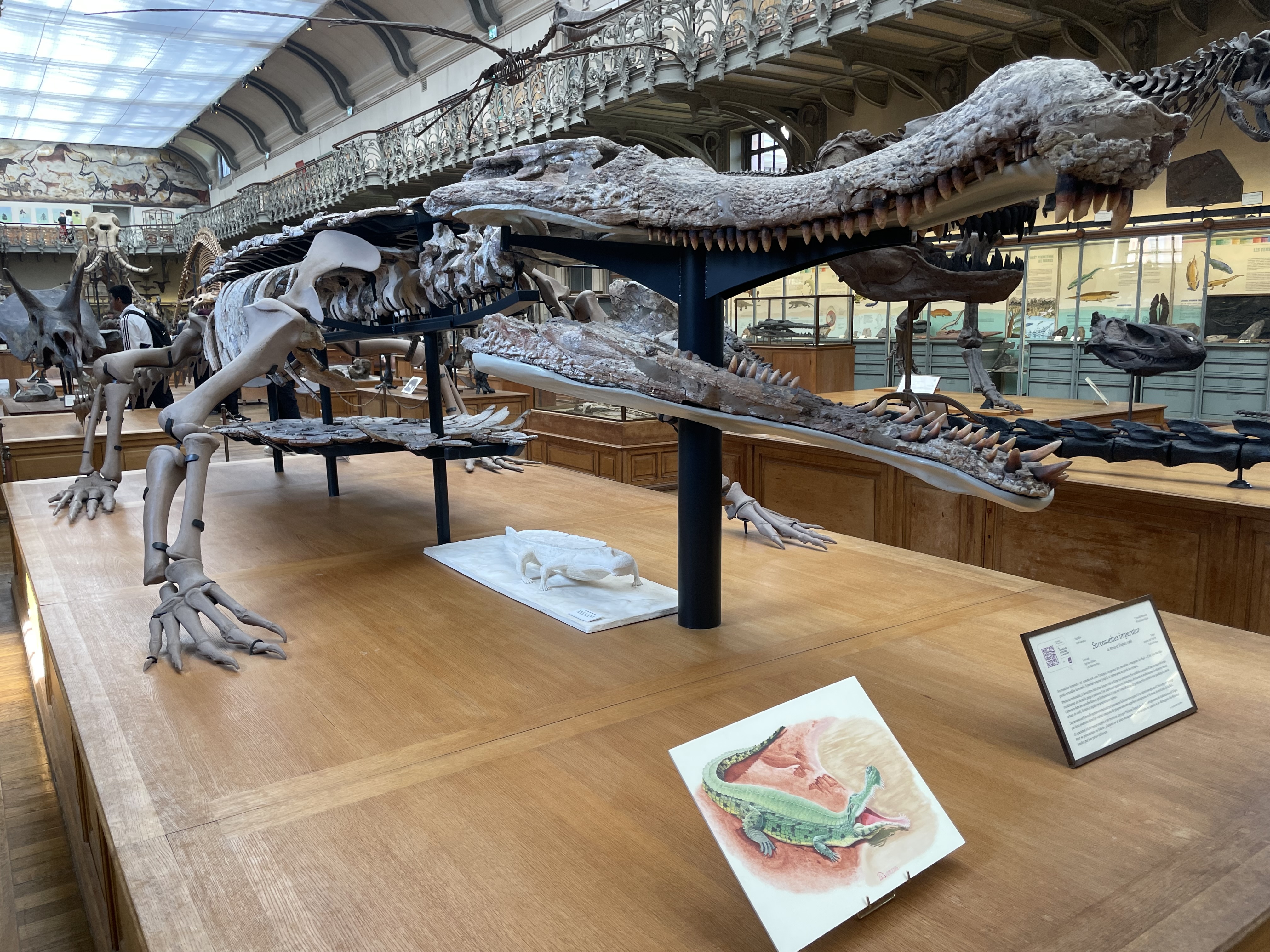
On the topic of crocs, here’s a big ol’ Sarcosuchus, one of the biggest crocs to ever live. This is the fossil I based my page image on, and it’s also the type specimen and even the page image for the Wikipedia entry for this genus! This is a famous fossil. Like many of the big mounted fossils, it has both a drawing and a little clay model presented with it. A cute, low-budget touch.
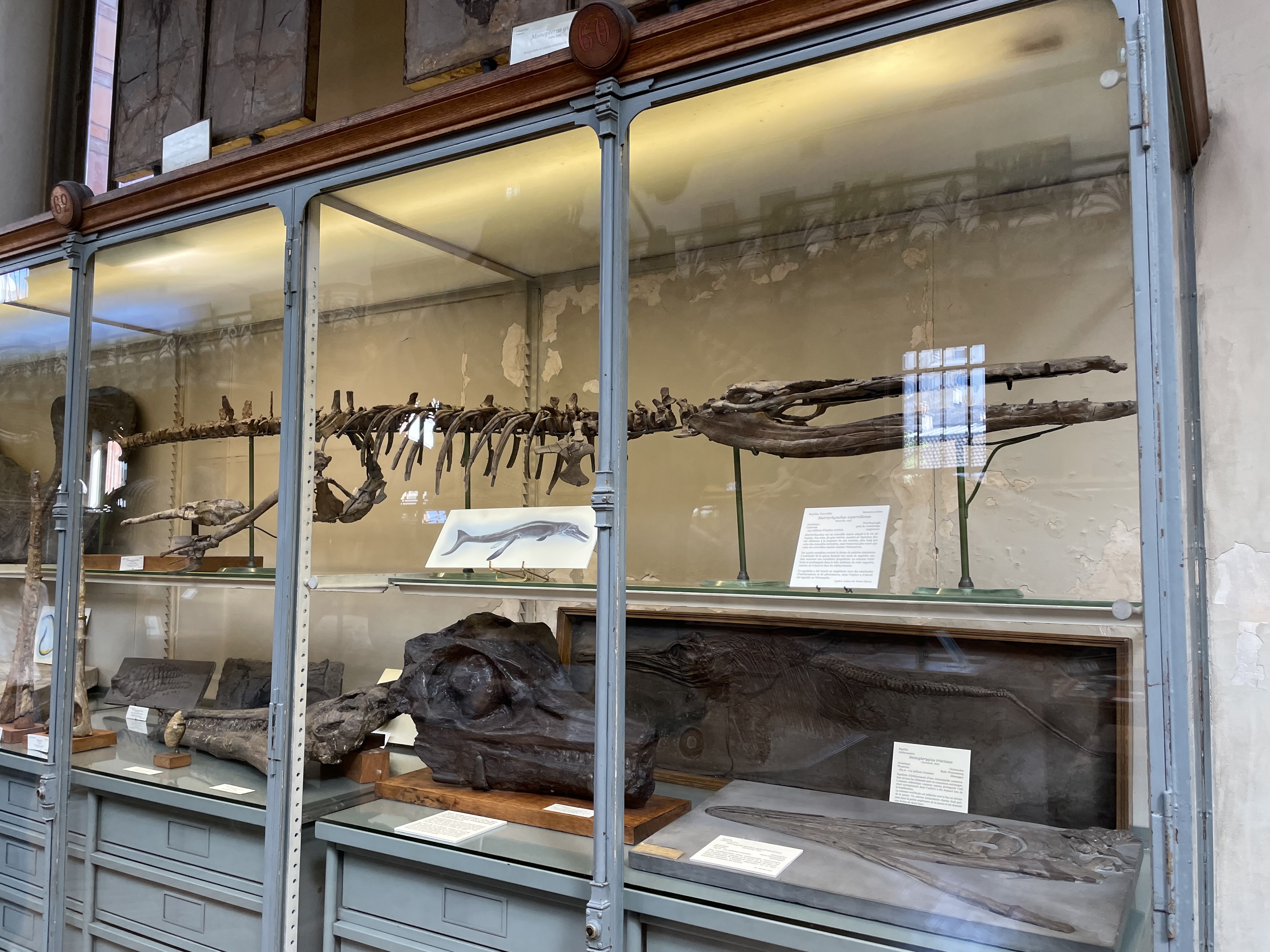
Here are a few other impressive marine reptiles, including a tiny ichthyosaur and a giant plesiosaur head. But the coolest one is the skeleton at the top, which belongs to the marine croc Metriorhynchus, the most marine that archosaurs (the bird/croc/dino lineage) have ever become. As far as we know, no archosaur has ever evolved to give live birth - except maybe this guy. It was so adapted for aquatic life, with a long fluked tail and paddles for limbs, it’s hard to imagine it coming up onto land to lay eggs… but maybe it still did, just very awkwardly. Need more fossils!
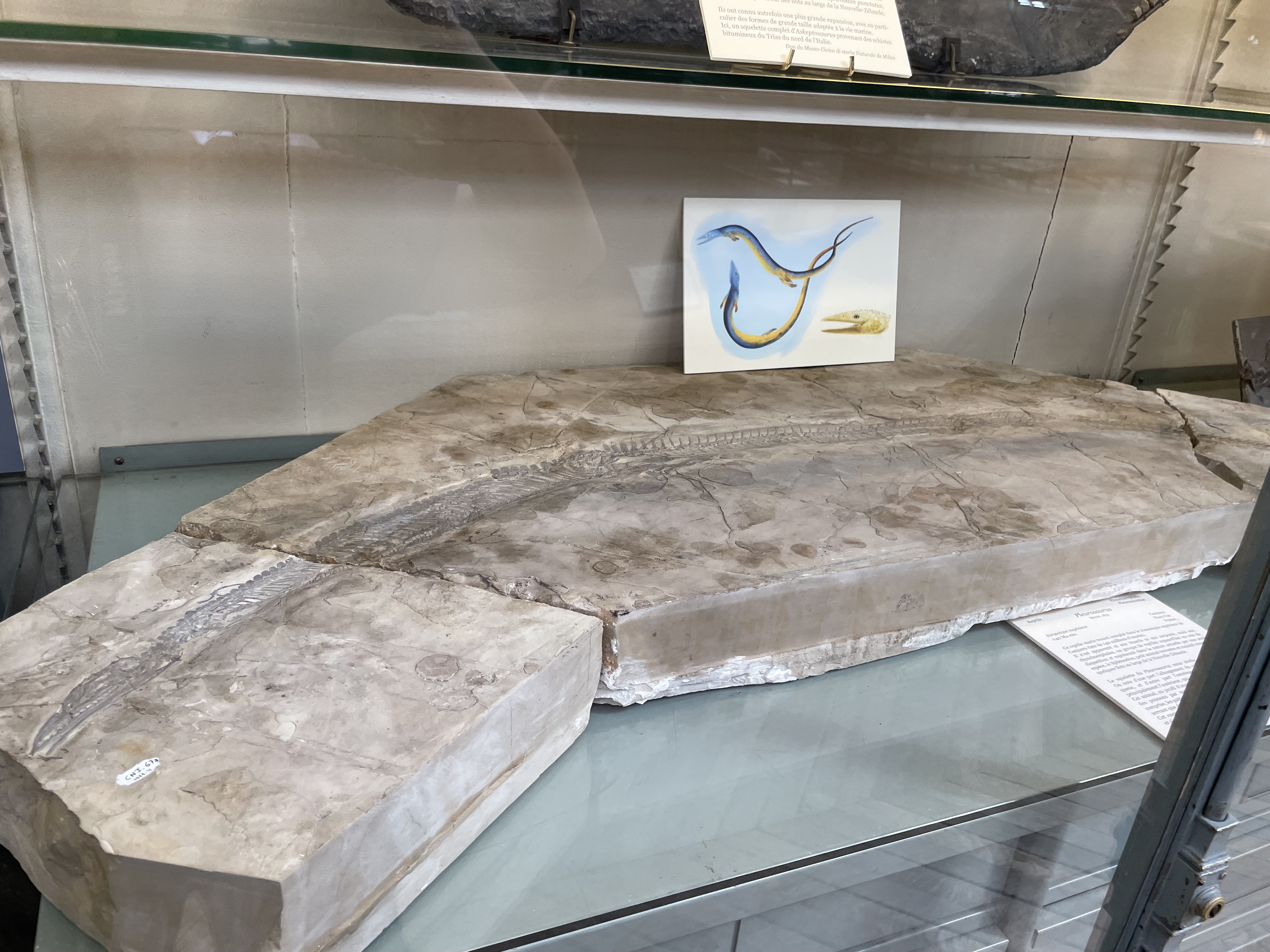
Did you know that there was once an aquatic tuatara? I didn’t, but that’s what Pleurosaurus is. It’s soooo long! And it lived in the Late Jurassic, a time of great marine reptile diversity, when it would’ve faced competition from plesiosaurs, ichthyosaurs, and metriorhynchids, rather than during the wacky, anything-goes Triassic, which is when I would’ve bet something like this would come from.
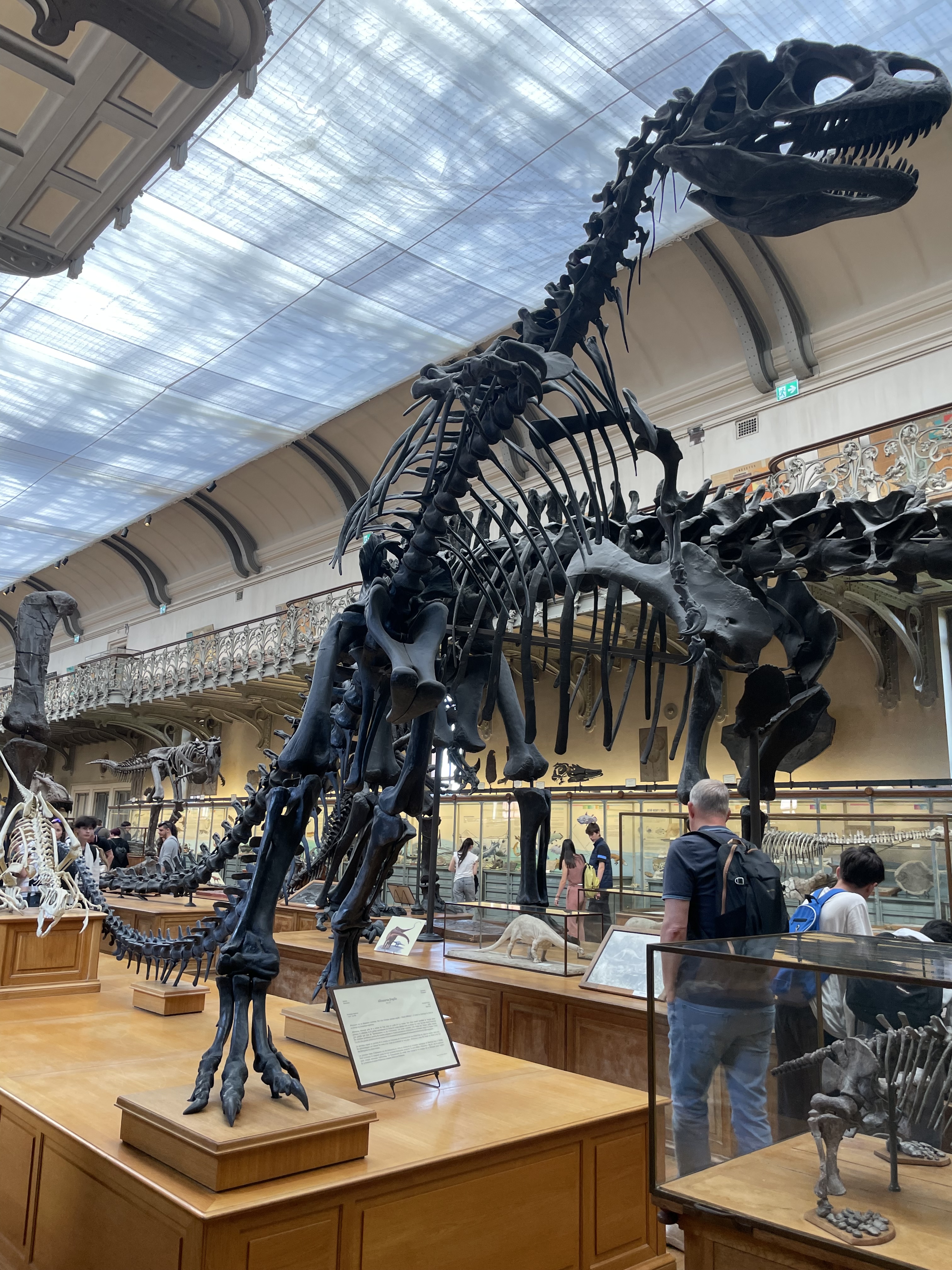
Finally, some dinosaurs! This is one of the big mounted dino skeletons that’s actually an original, an Allosaurus. Its coracoid (chest) bones are not touching and its legs are too close together, but overall not a terrible pose.
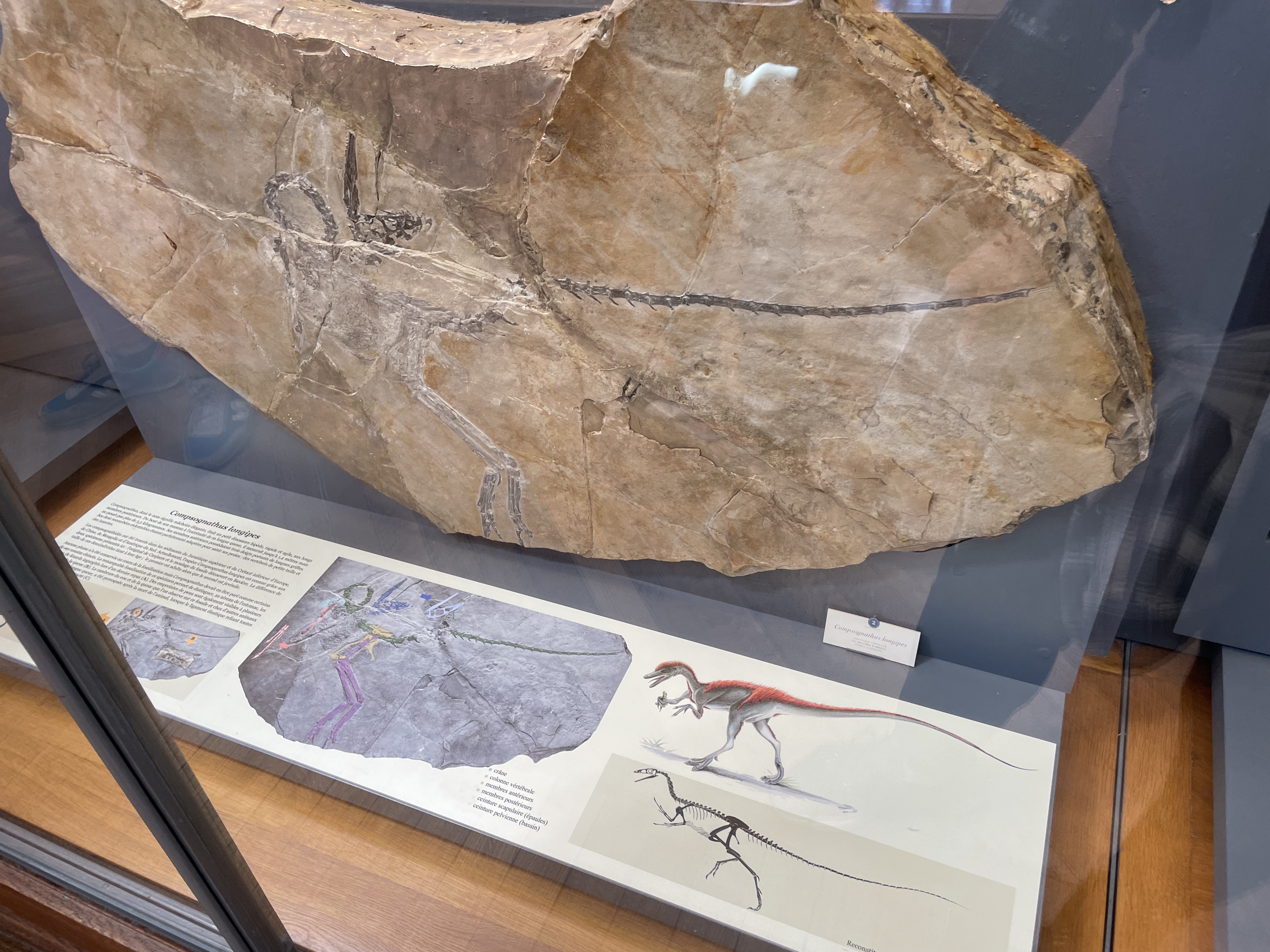
This is one of the two specimens known of Compsognathus, a famous small theropod dinosaur that was discovered back in 1859. For many years it was the only small dinosaur known, and it was notable for being obviously reminiscent of birds, especially Archaeopteryx when that was discovered.

This tail segment belongs to a dubious sauropod genus called Bothriospondylus. As the sign here explains, a dubious genus is one whose validity is doubted, but the name is still in use because no one has yet done the work to figure out how this fossil should actually be classified. A neat tidbit.
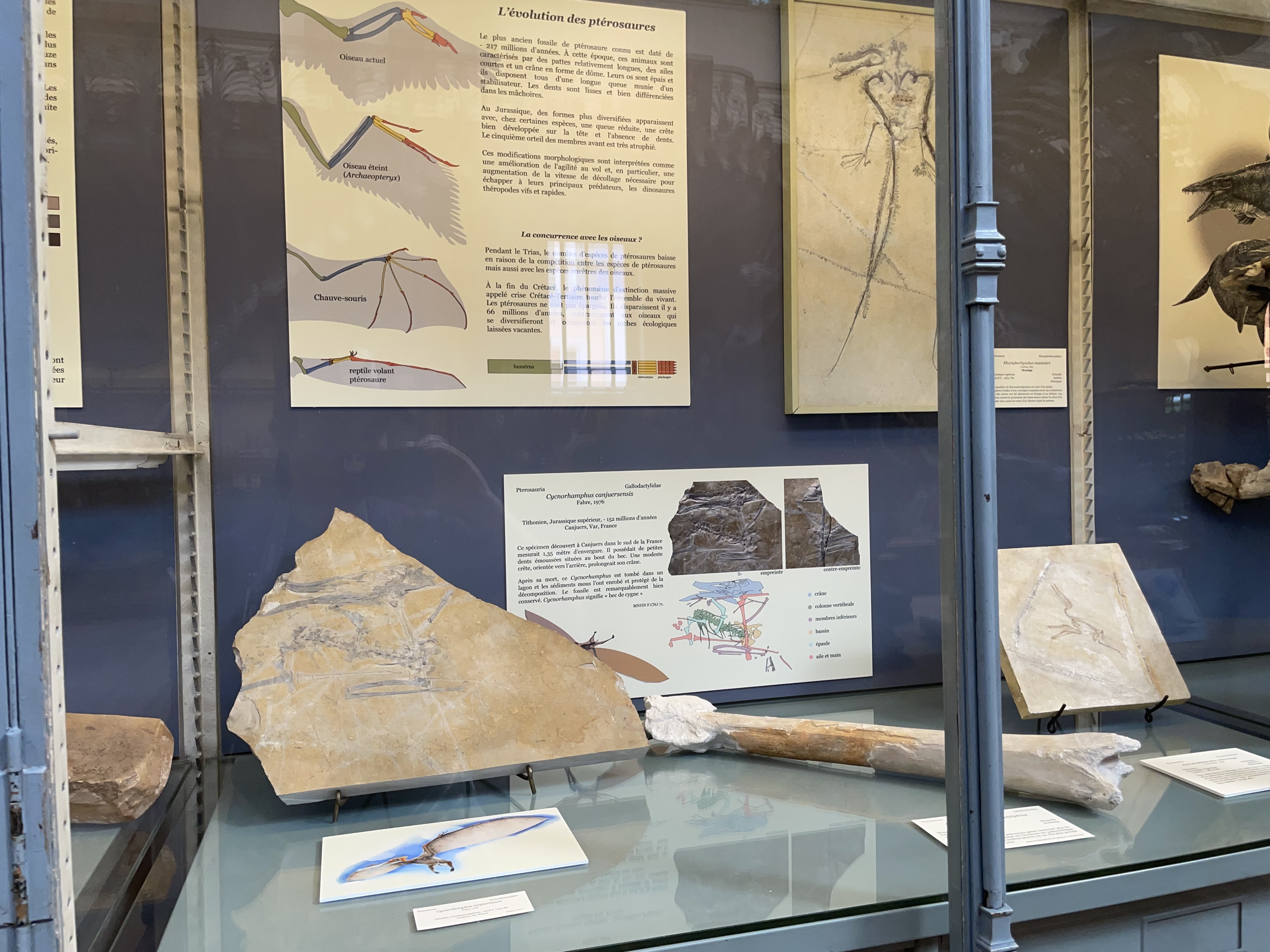
Here’s a cool pterosaur specimen, Cycnorhamphus, a bird-sized species that might have fed like an openbill stork, but might have been doing something more mysterious (the exact anatomy of the end of its bill is debated). Strangely, this sign says that the number of pterosaur species declined in the Triassic due to competition with the ancestors of birds. This is not true, nor has it ever been proposed seriously, as far as I know. Pterosaurs were doing quite well for themselves throughout the Jurassic and Cretaceous, and birds only achieved flight in the Late Jurassic. Why would early flightless bird-relatives compete with fully flighted early pterosaurs at all?
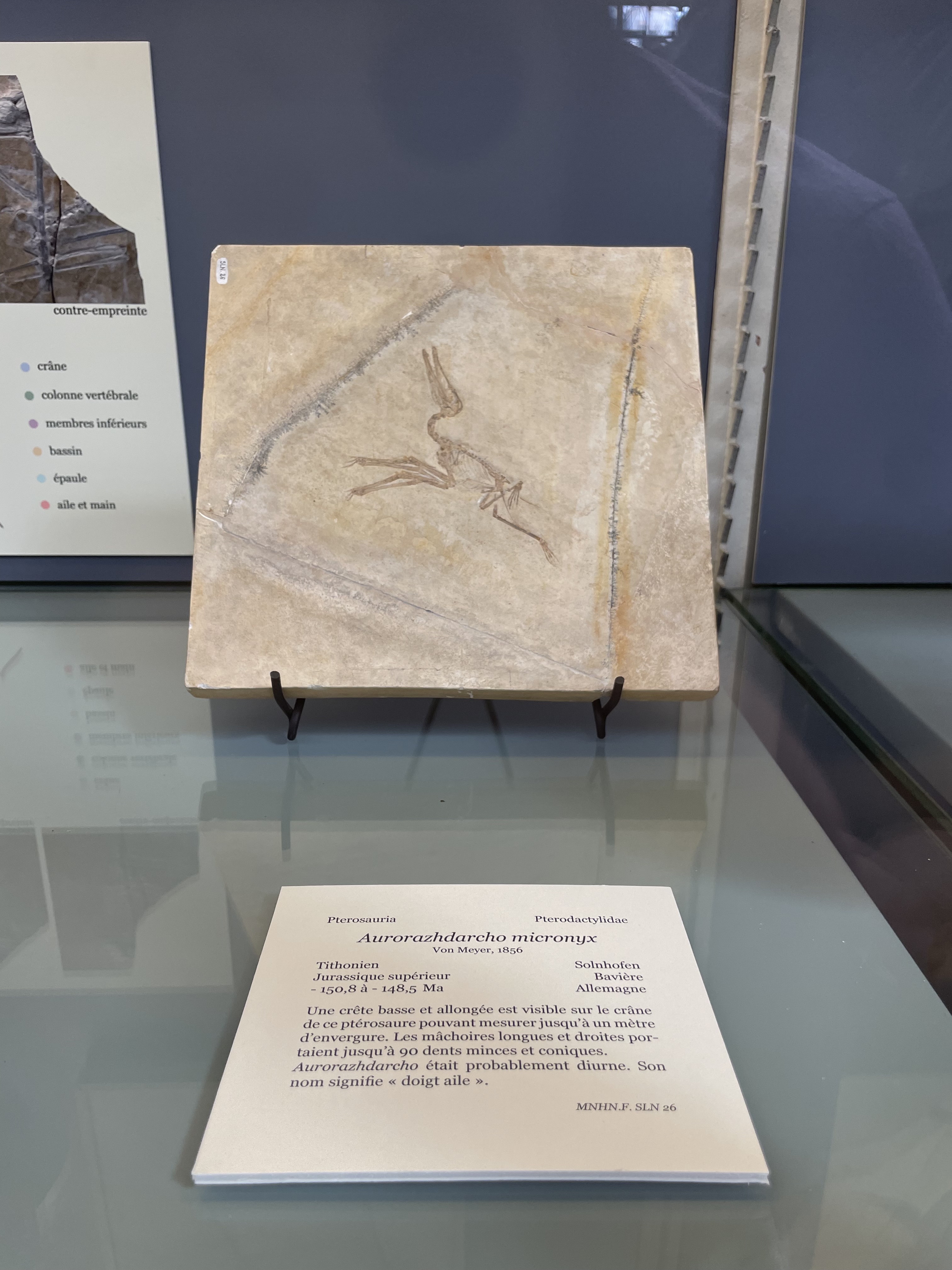
Here’s another pterosaur, Aurorazhdarcho, an early, very small azhdarchid (the group that includes the later plane-sized pterosaurs such as Quetzalcoatlus). However, this specimen was originally identified as a species of Pterodactylus, which is why the sign still claims that its name means “wing finger”. “Aurorazhdarcho” means “dawn dragon”. Confusing…

For our last stop in the Mesozoic, here are some intimidating mosasaur jaws. Isn’t it crazy that mosasaurs lived and died within the Late Cretaceous? Such a short time on this Earth for such cool creatures.
There were more dinosaur and other Mesozoic specimens, but they were either casts, or I didn’t think they were interesting enough to mention, or I didn’t get a clear enough picture of the sign to know what the museum was saying about it.
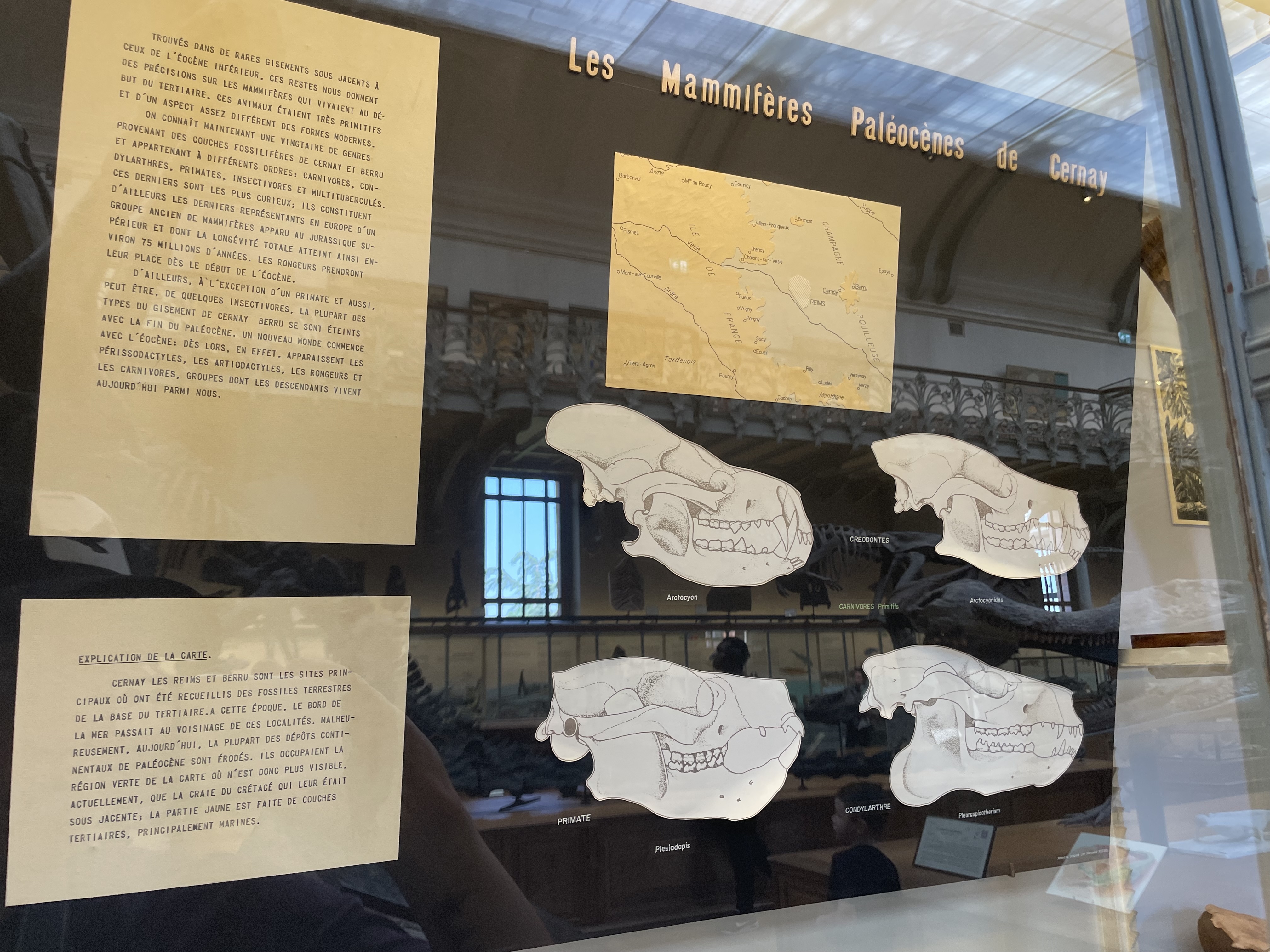
The museum focused a lot on Paleocene mammals, which I expected due to the famous father of paleontology Georges Cuvier (1769-1832), who hailed from France and discovered a lot of them. He basically invented the concepts of extinction and biostratigraphy, and did a lot of work on taxonomy as well, building on Linneus’s foundation. However, it was a weird time to be a paleontologist, because he died decades before Darwin’s work was published. So Cuvier’s working theory was that there were Biblical floods every few million years that wiped out everything, and then God created everything anew each time.
All the posters on this side of the hall were much older and more technical than the ones on the Paleozoic/Mesozoic side. This one talks about the weirdness of the post-apocalyptic Paleocene fauna, how there were a bunch of mammals that very quickly adapted from small burrowers to filling all the large animal niches, but were soon displaced in the Eocene by other mammals that were more specialized and more representative of what we have today.
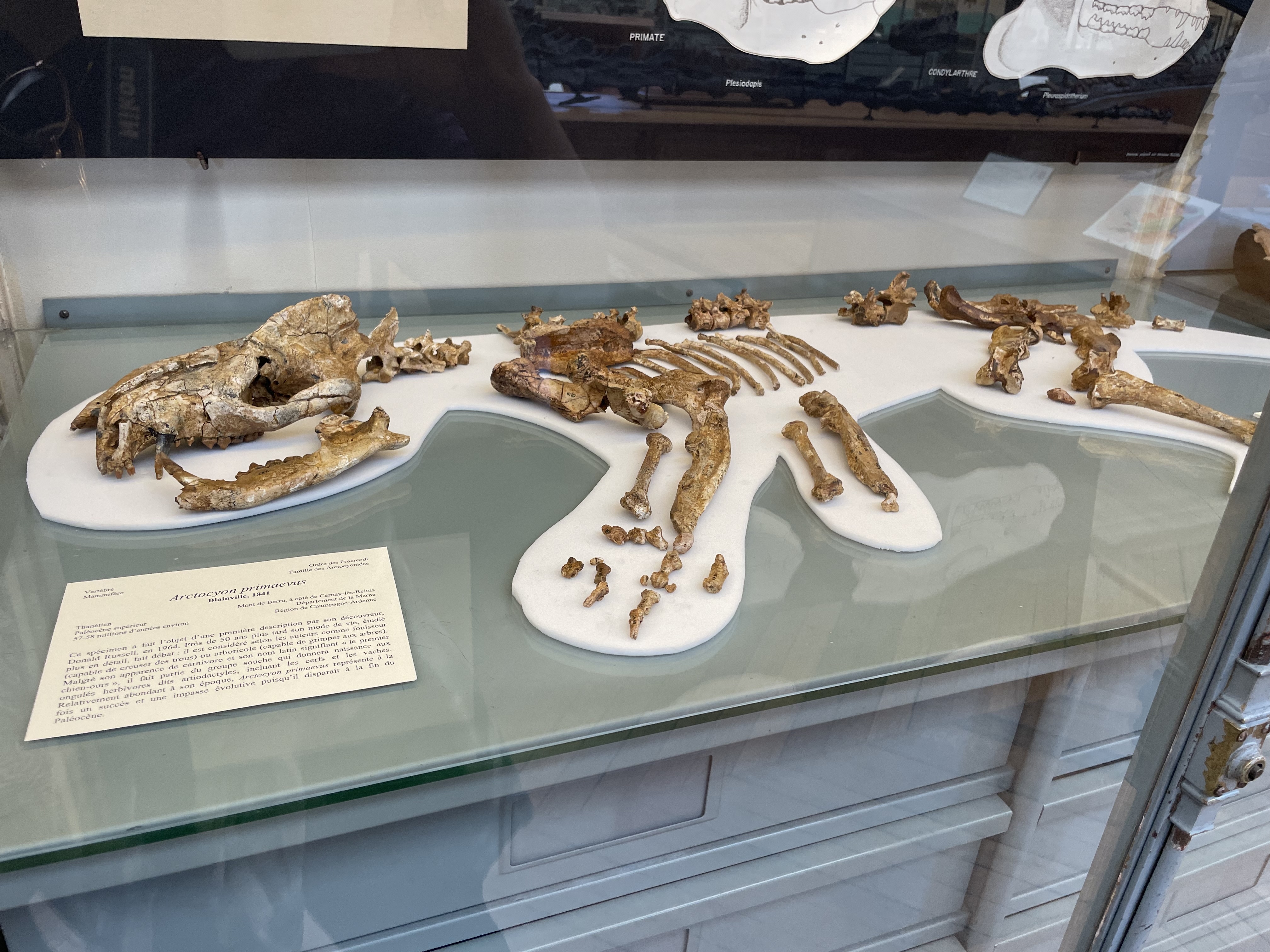
Underneath that poster is this skeleton of Arctocyon, a Paleocene mammal of uncertain affinity. The sign claims it’s related to artiodactyls, which is a valid hypothesis but far from the only phylogenetic placement possible. This specimen is the page image of Arctocyon’s Wikipedia page.
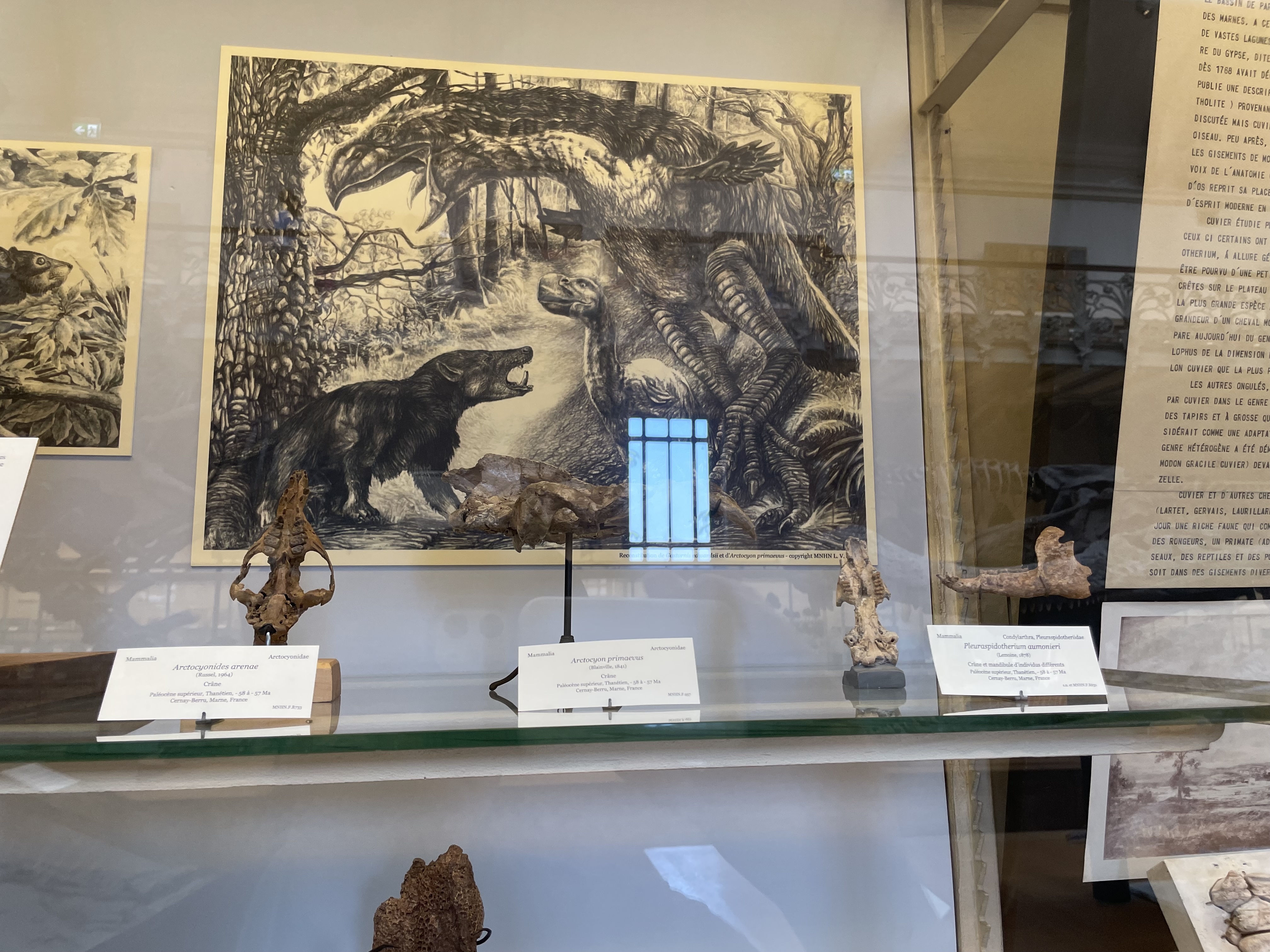
Here are some more Paleocene mammal skulls, as well as an art piece depicting Arctocyon facing off against a mother Gastornis and her chick. The black and white makes it a bit hard to interpret what’s going on. And hasn’t this museum ever heard of museum-grade anti-glare glass?
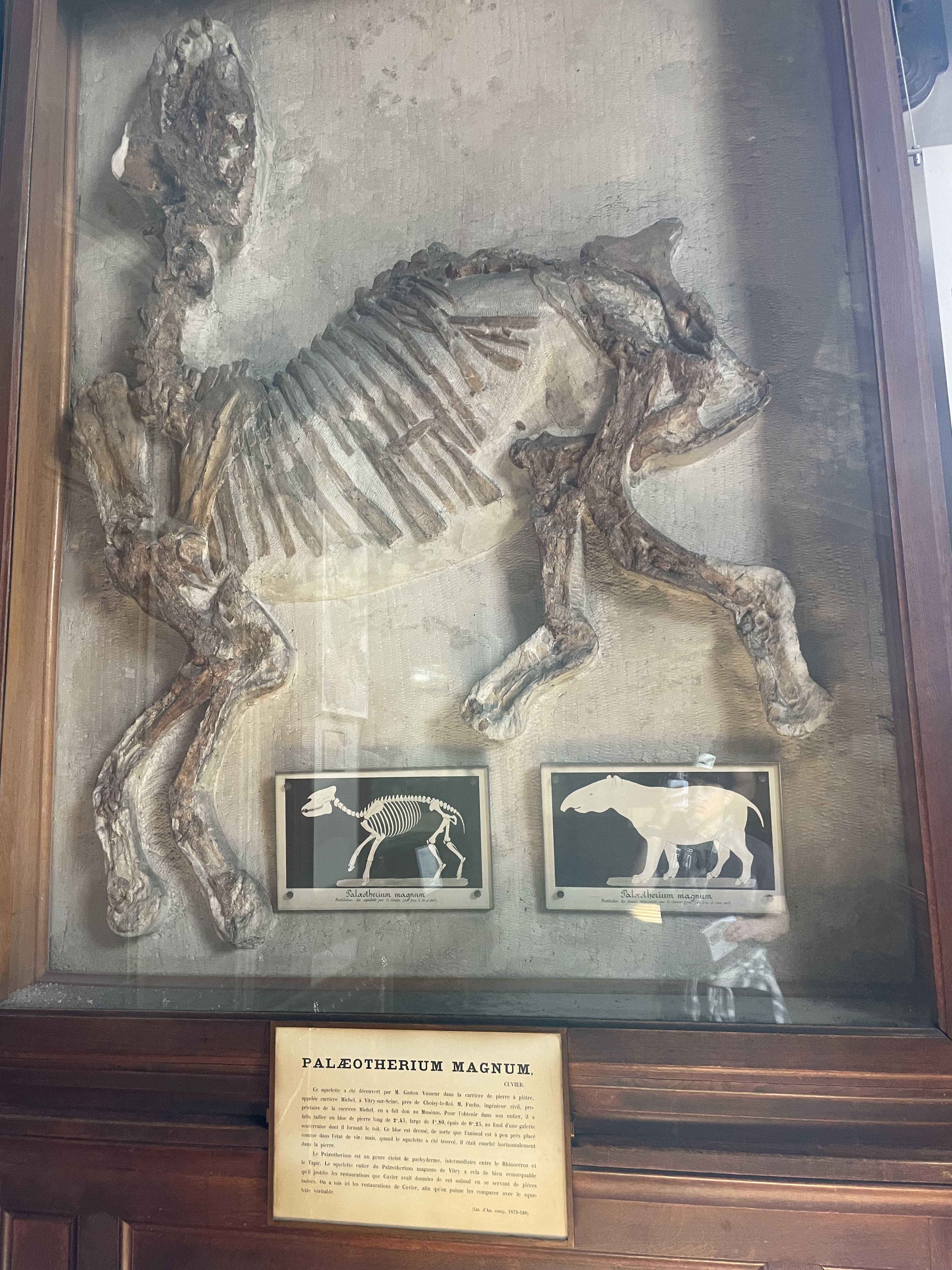
This enormous Palaeotherium specimen was placed not in the fossil hall, but in the stairwell! This genus was one of the ones named by Cuvier, back in 1804. The two little drawings there were done by Cuvier. The sign describes that the fossil was found as part of the roof of a cave. It also calls Palaeotherium a “pachyderm”, an outdated term that meant “large gray-skinned mammal” but was not a meaningful phylogenetic group and has thus fallen out of use.
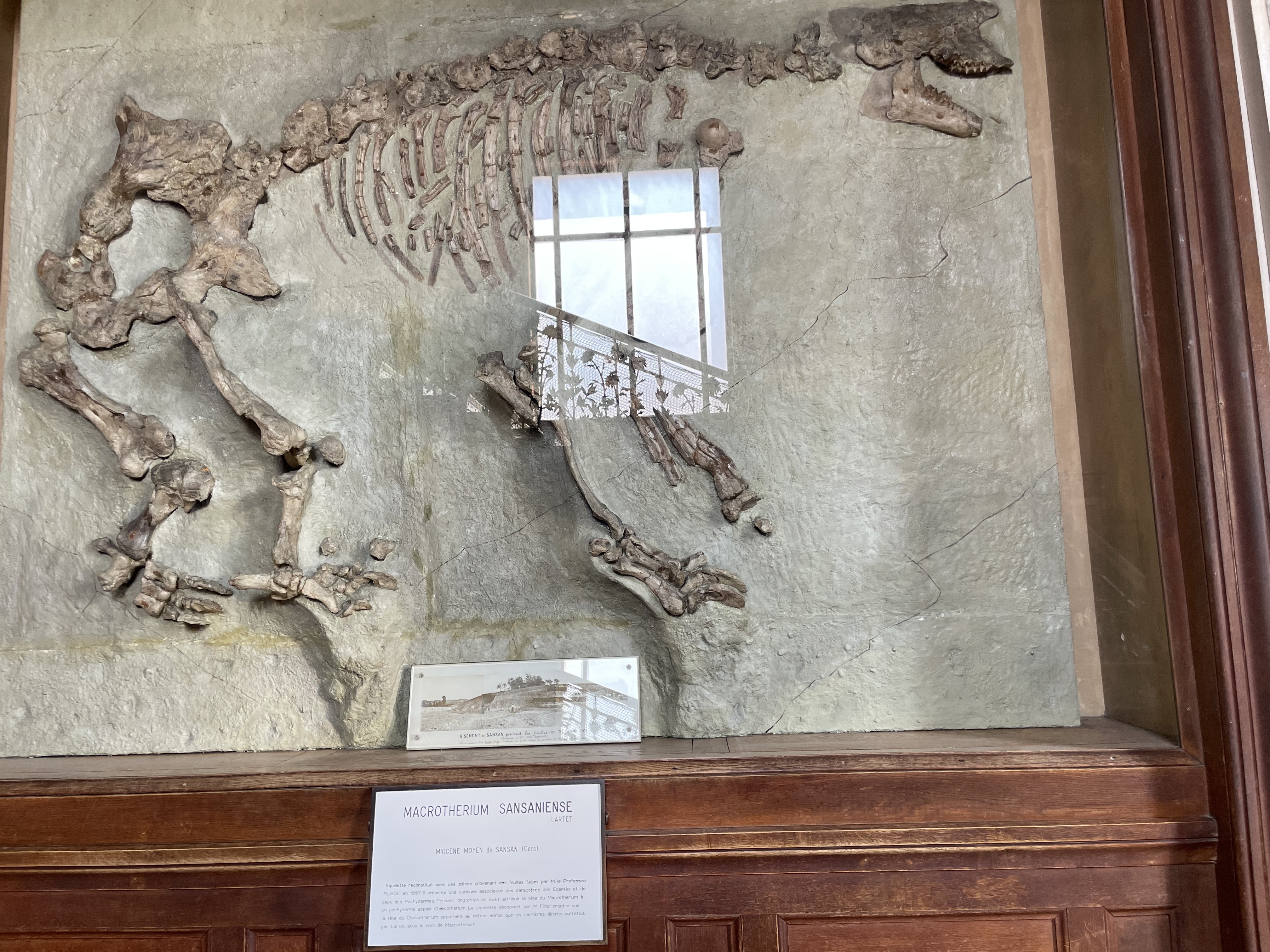
This skeleton, also in the stairwell, is labeled “Macrotherium”, a synonym of Chalicotherium. The sign says something to this effect, except in a really confusing way. It says that the head of “Macrotherium” was attributed to Chalicotherium, but this skeleton shows that the head of Chalicotherium belongs to the body of “Macrotherium”? What?? Anyway, they both refer to the same animal, a horse relative that walked on its knuckles like a gorilla, from the Miocene.

Here’s a neat mounted skeleton of Thalassocnus, the aquatic giant sloth from the Miocene. You can really see its heavy, heavy bones, especially the ribs! Those would have weighed it down in the water, enabling it to dive.
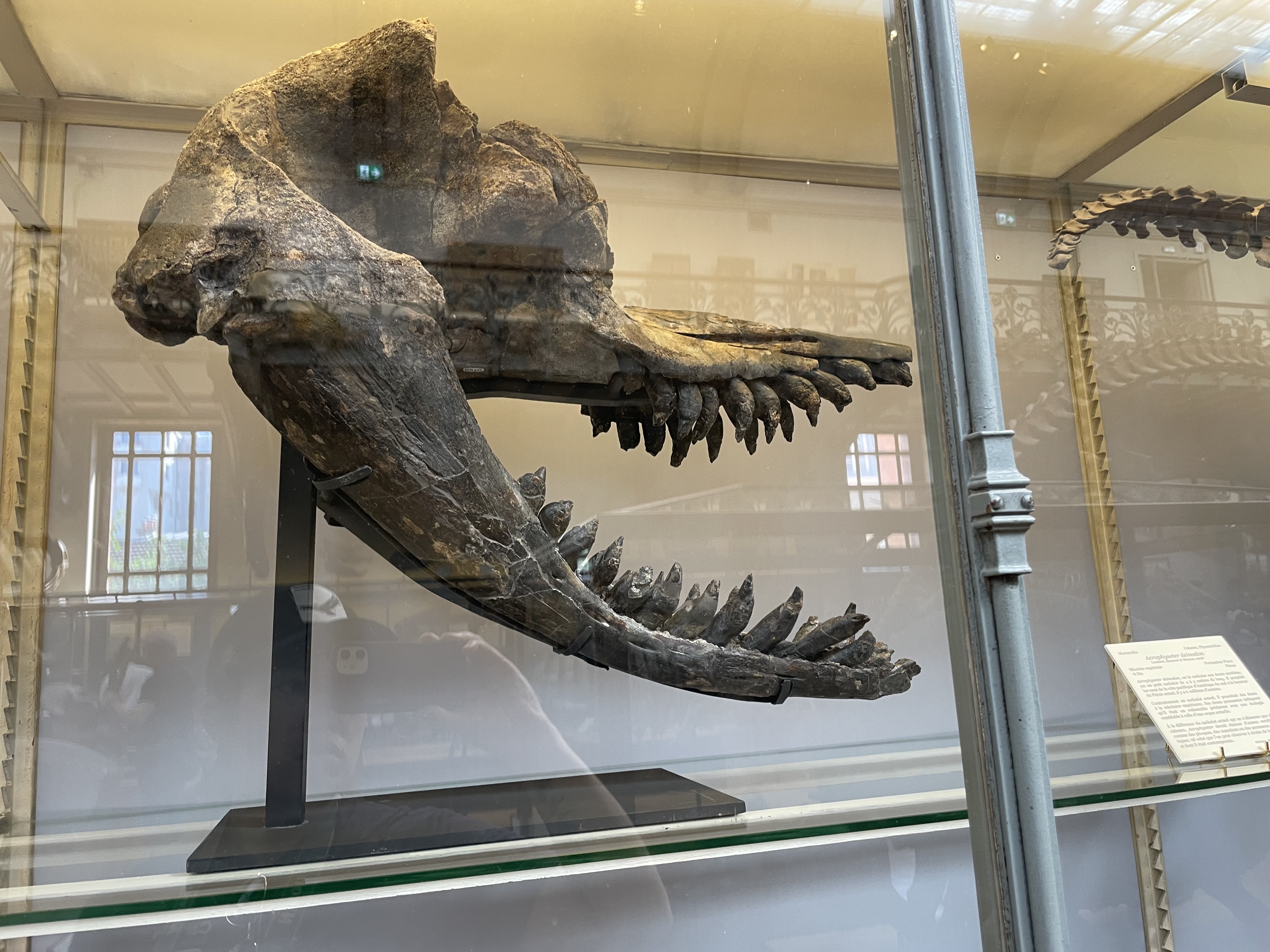
This terrifying skull belongs to Acrophyseter, a Miocene sperm whale. Sperm whales eat soft squid; why do they need such crazy teeth? Maybe because killing the squid is the hard part, not eating them?
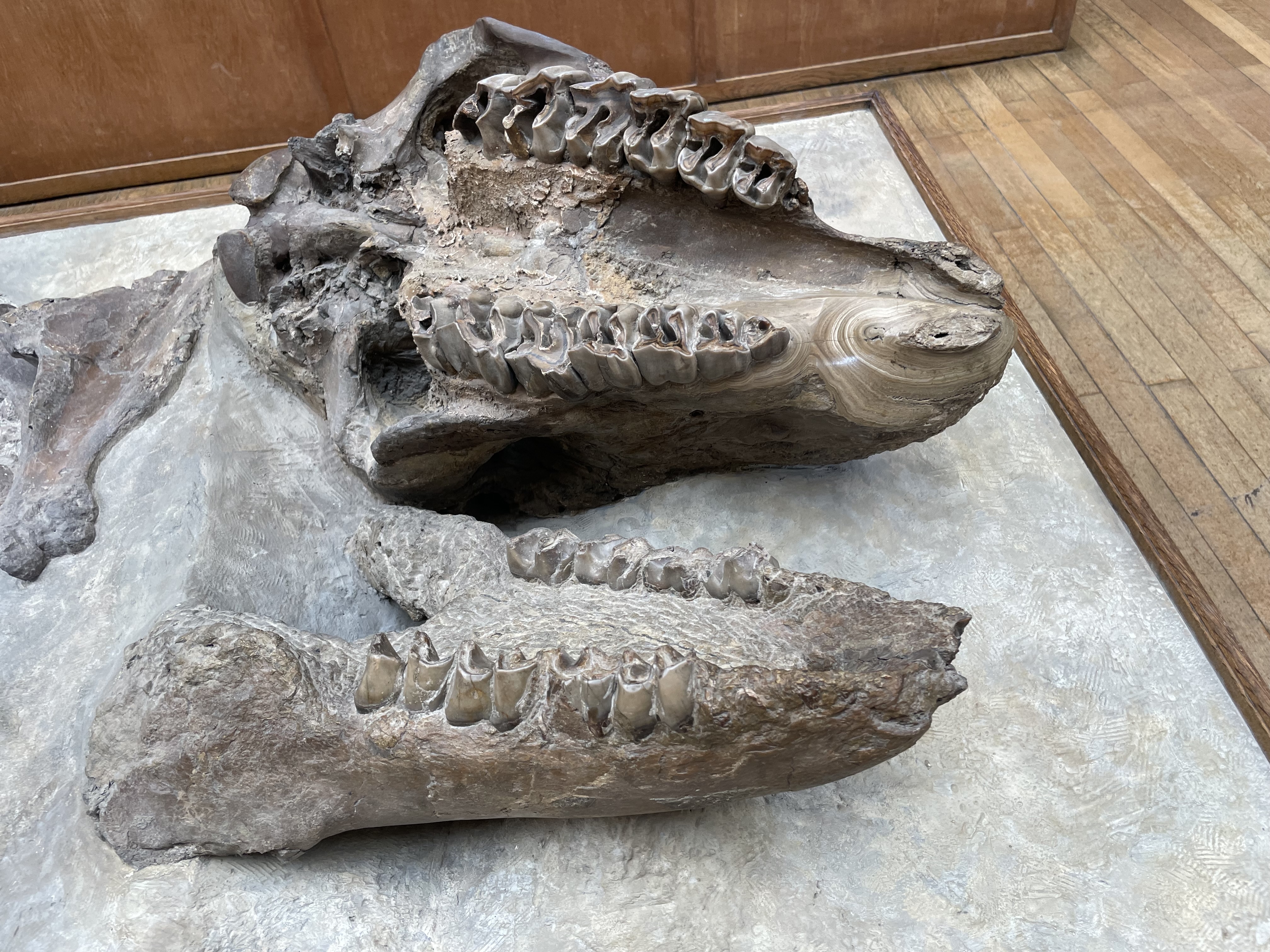
This skull of Diceratherium, an Oligocene rhino, has some really interesting stone patterning inside. I’m pretty sure this doesn’t have to do with the way the animal was in life, but is just a characteristic of the way it was fossilized. It’s weird to think that fossils are actually made of stone, not bone.
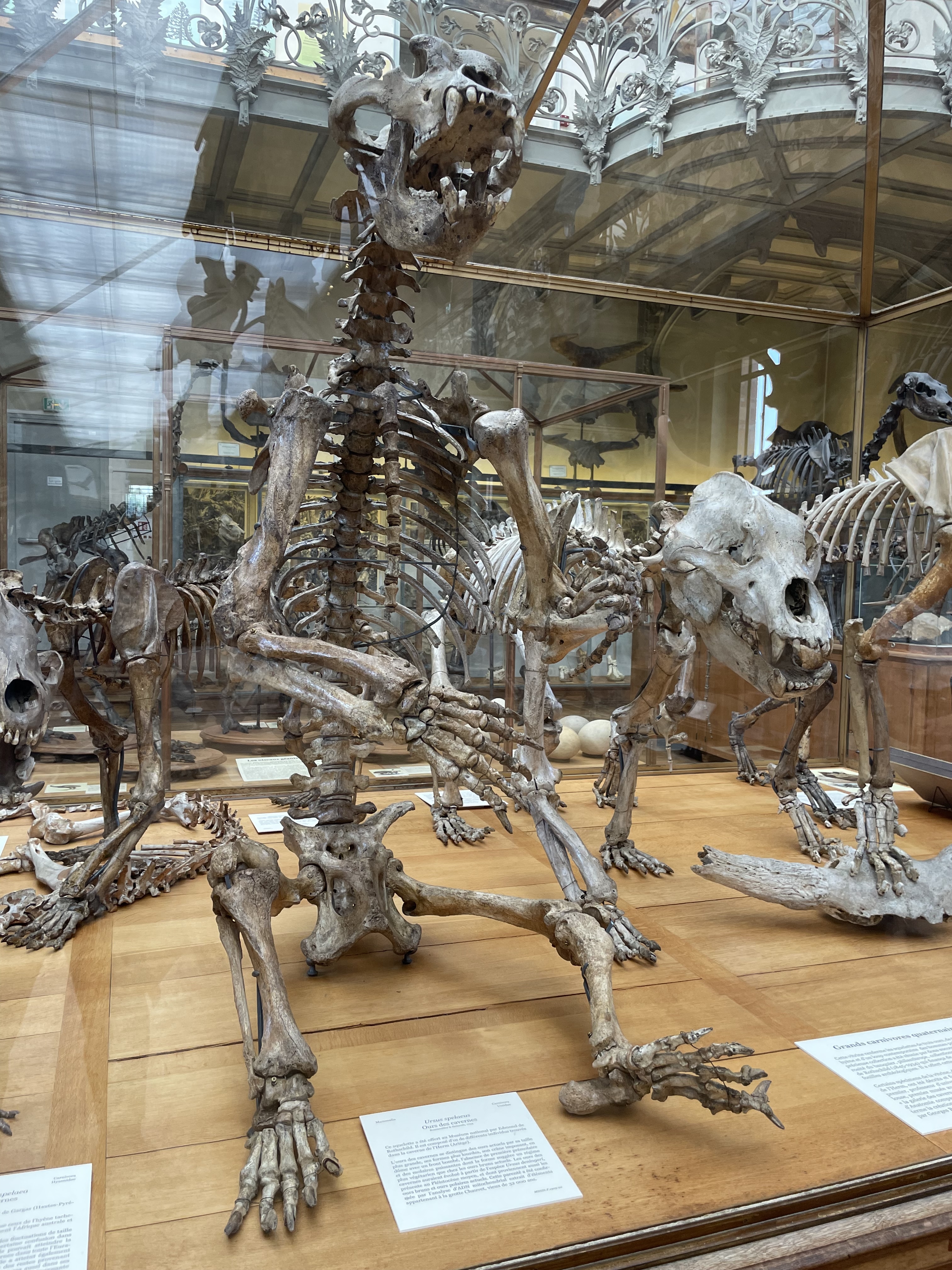
This is a cave bear, Ursus spelaeus, a relative of today’s grizzly bears that was more herbivorous. There was certainly an impressive amount of mounted Pleistocene megafauna in the back of the hall. Apparently in French, DNA is ADN.
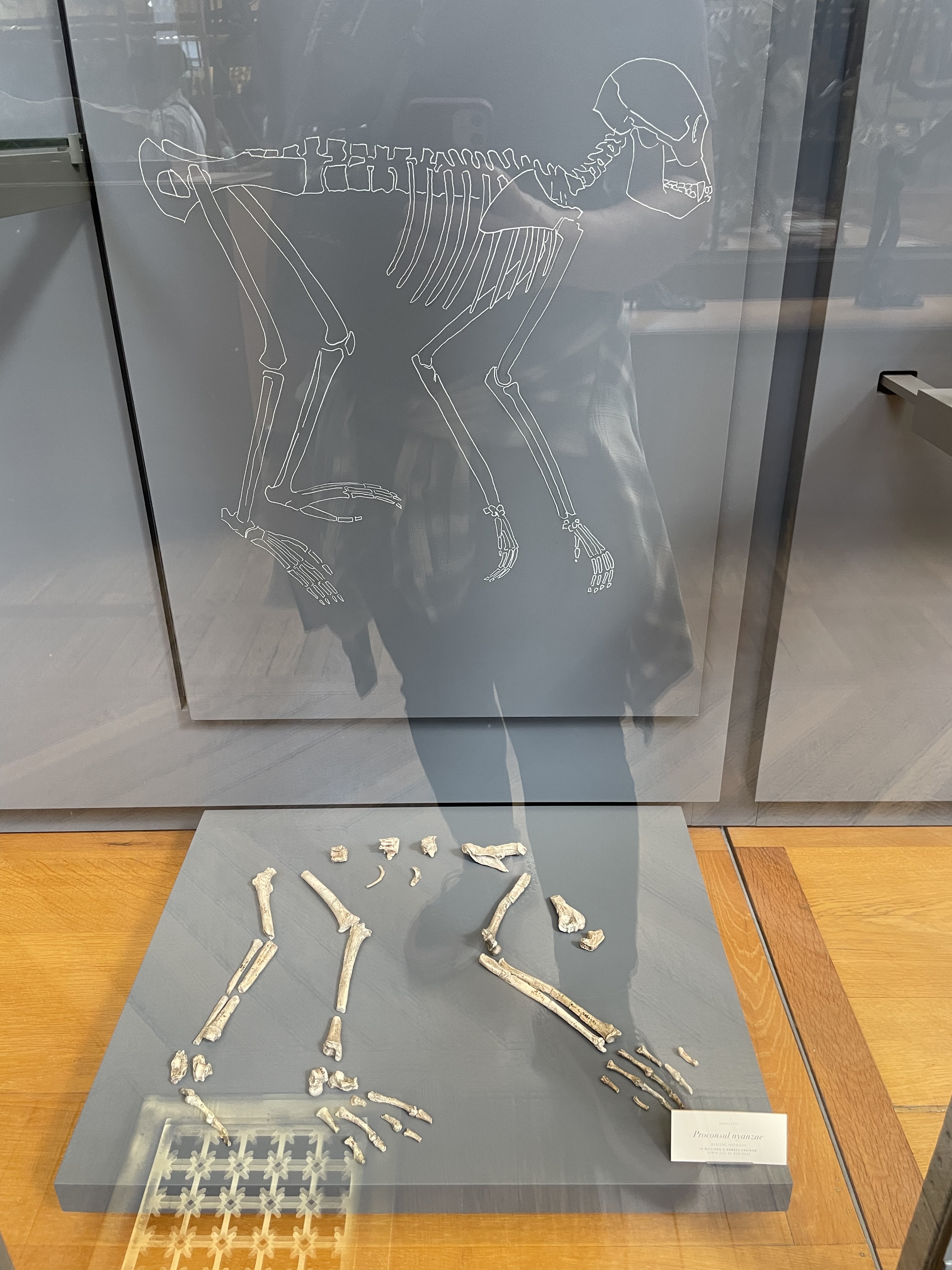
This skeleton might not look like much, but this genus represents the oldest known ape, Proconsul, which lived 28 million years ago.
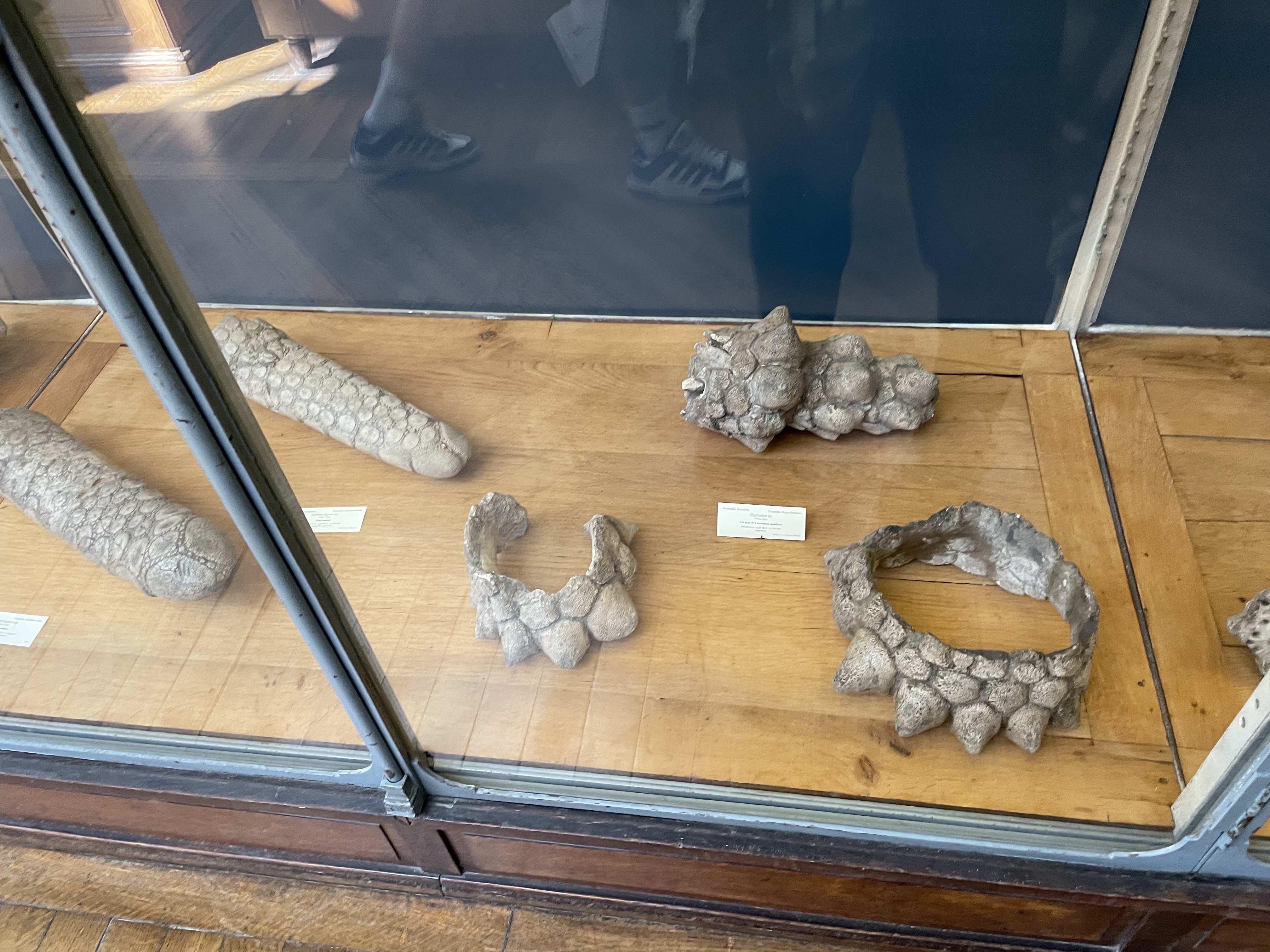
These…suspicious-looking objects are segments of the tails of glyptodonts, which were giant Pleistocene armadillos. This museum also had a big mounted glyptodont skeleton, but I thought these pieces were interesting detail views.
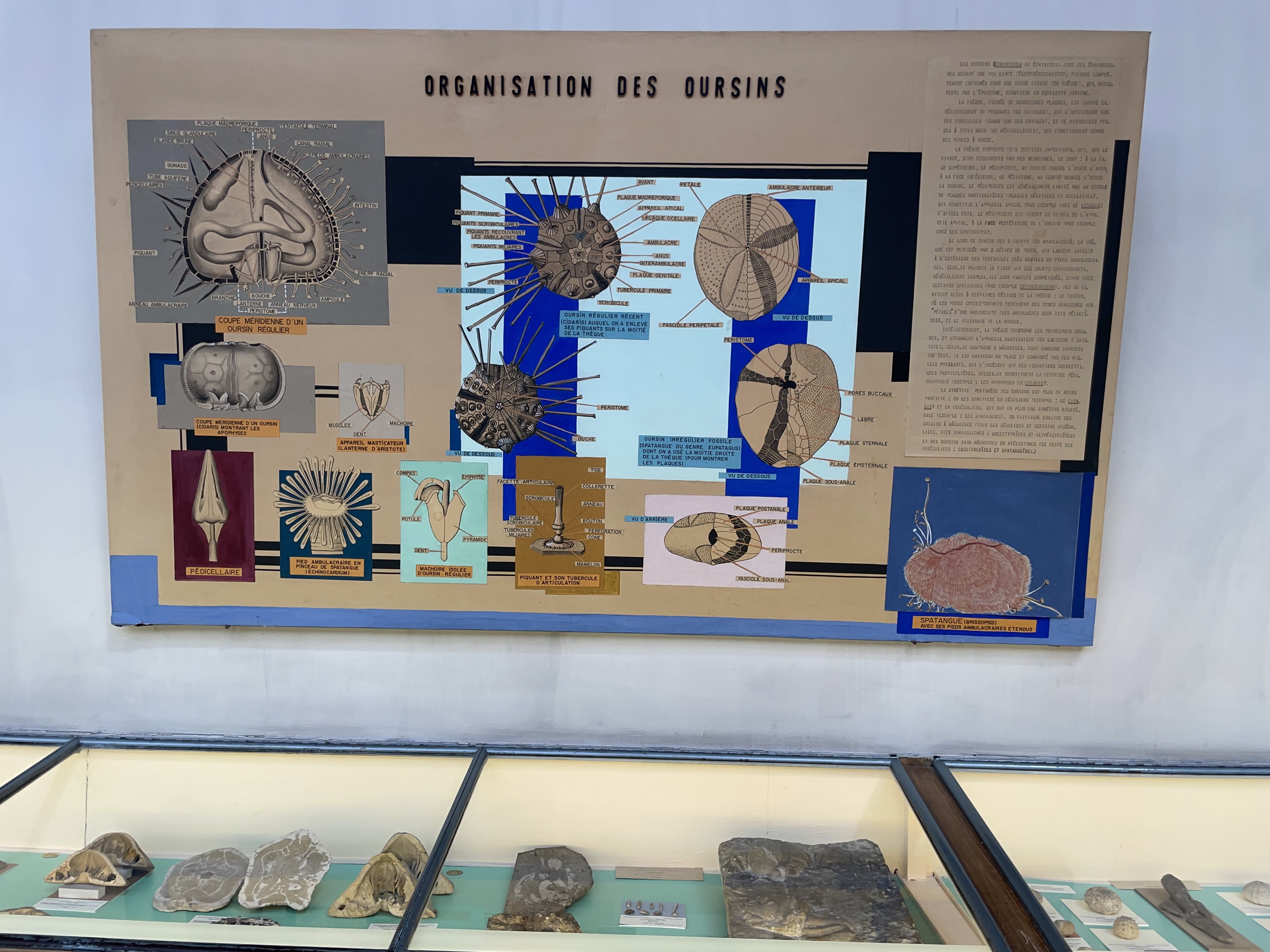
Heading upstairs to the third floor, we find the invertebrates. This section of the museum was the most technical of all, with diagrams like this all over the walls explaining the phylogeny and anatomy of things like sea urchins (“oursins”) and brachiopods.
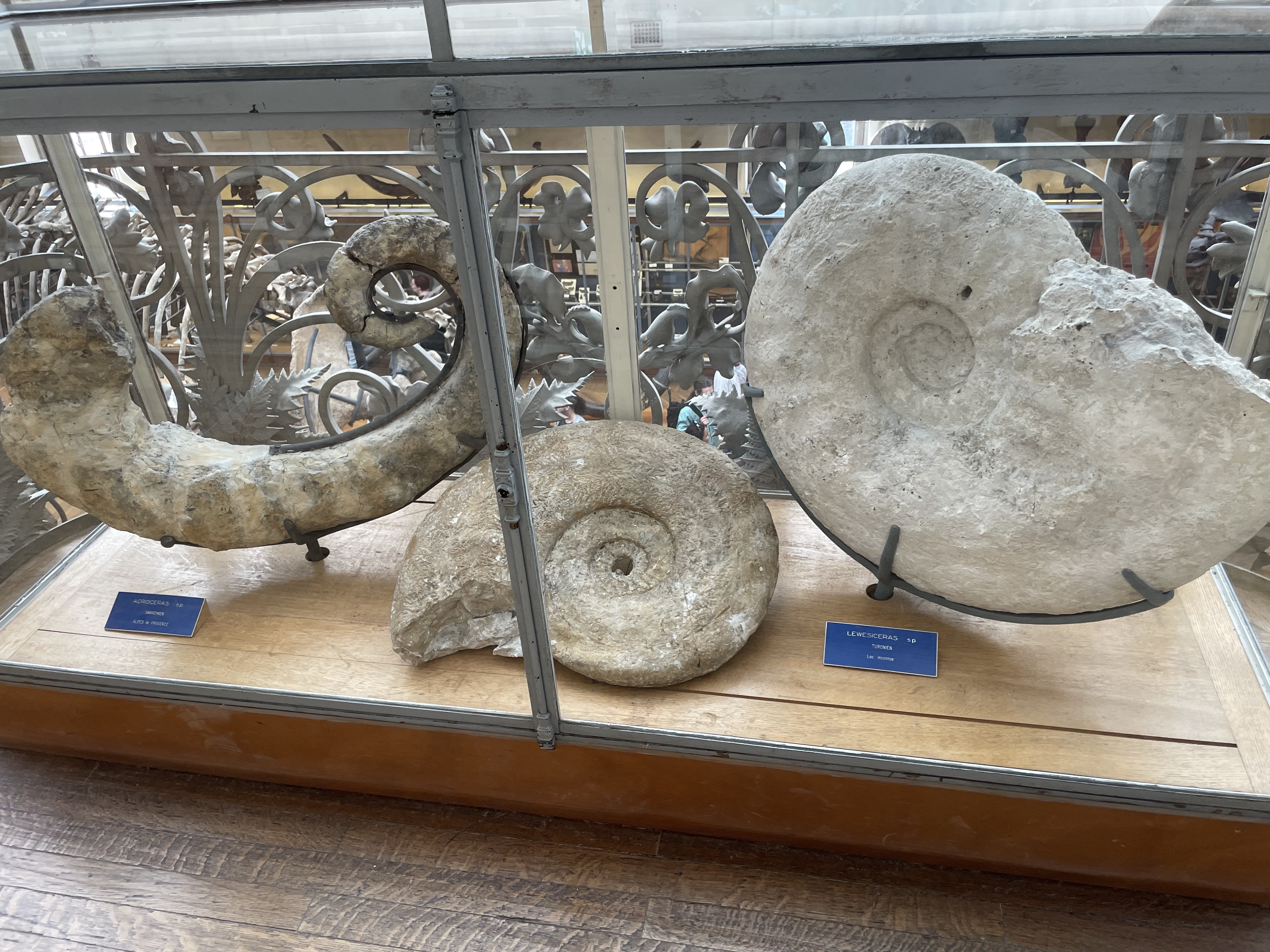
Here are some impressively large ammonites, including the weirdly uncoiled Acrioceras. I really don’t understand how such un-hydrodynamic creatures could have been selected for. But they were! And even weirder shell shapes existed, like the tangled Nipponites, the helical Didymoceras, and the paperclip-shaped Polyptychoceras.
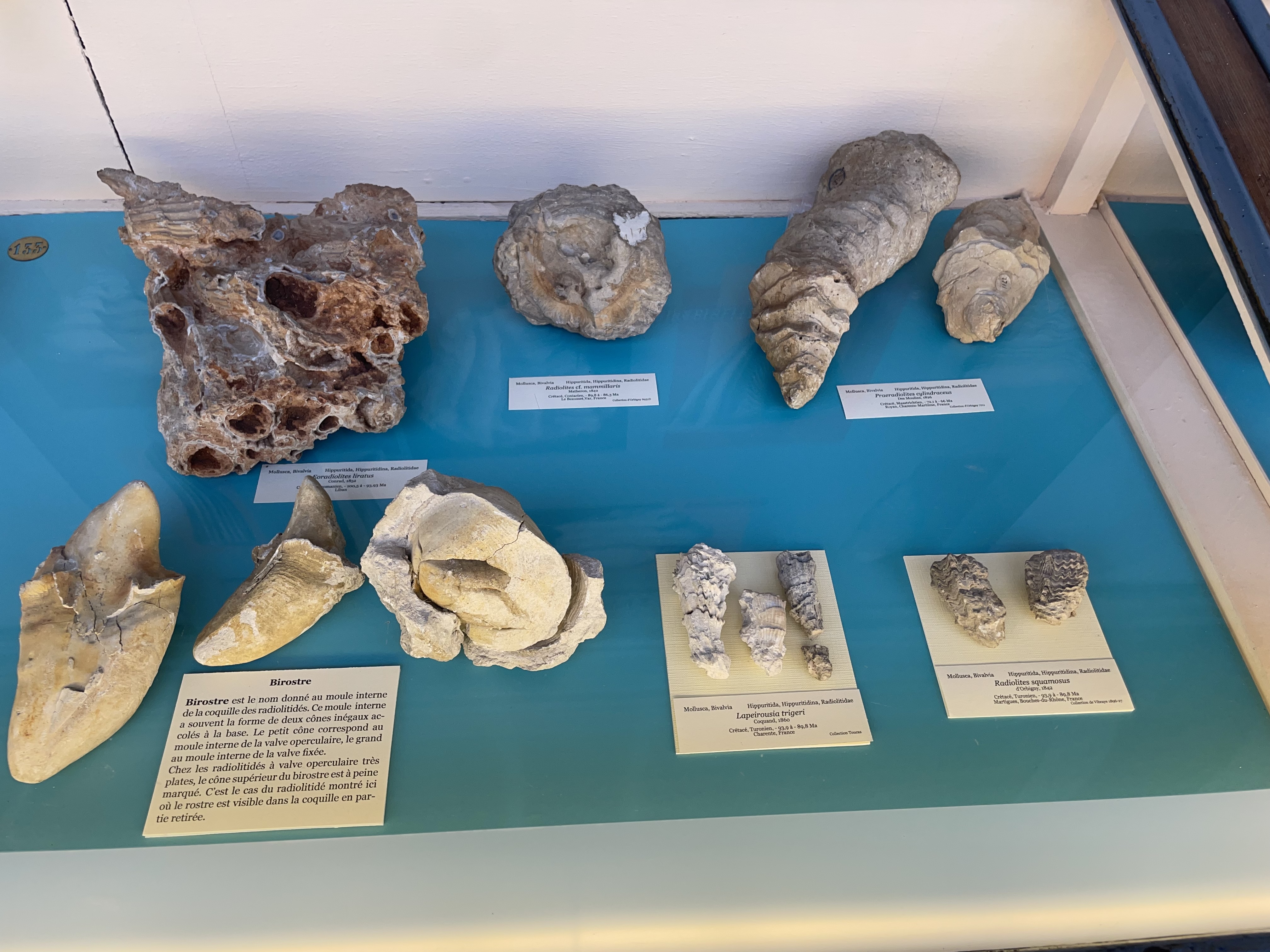
I won’t go into much further detail on the inverts because I don’t have that much background in them and I was running out of time in this museum by this point. But I wanted to discuss rudists, just a little. These were bivalves like clams, except each side of their shell was huge and horn-shaped. How did they live?? It seems like they would not have been able to easily open and close the valves, and the space in between would’ve been so tiny that there would have been very little interaction with the environment relative to their total internal volume.
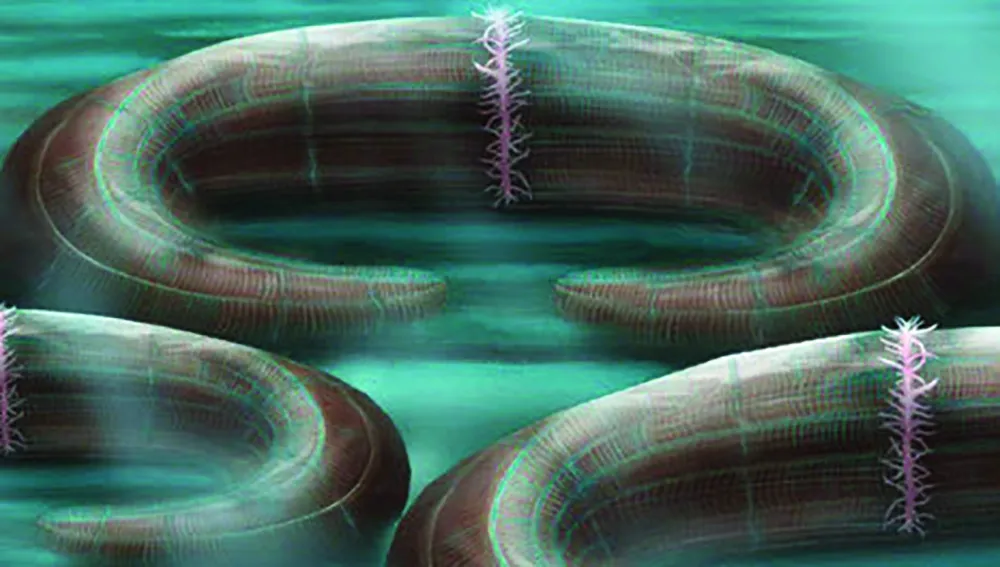
Here’s an artist’s interpretation of a living rudist. In the Mesozoic, these gigantic mollusks (up to 2 meters across) were important components of reefs. But…how??? What was all that internal volume for?
There was a lot more than this on display in this museum - it would take a long time to get through everything despite the deceptively small size of the building! But overall I thought this was a really interesting experience, especially because the museum is a combination of new and old science communication techniques.

